Links for Digital Musicology
This wiki provides links to substantial open-access projects of use to musicians and musicologists. For curated digital editions, see EVE: Electronic and Virtual Editions. For older projects that are not readily accessible online see ADAM: Archive of Digital Applications in Musicology.
Digital Music Reprints
Out-of-copyright editions reproduced in their entirety. Grouped by composer, collection (i.e. within a library or a series), publisher and sheet music (subjects variable, usually from one institution).
By Composer
Ludwig van Beethovens Werke
The first collected edition of Beethoven's music was published by Breitkopf & Härtel, in Leipzig, between 1862 and 1888. This set contains 269 titles—symphonies, concertos, chamber music, Lieder, folksong arrangements, and much more.
Brahms Institute: Digital Archive
Website: http://www.brahms-institut.de/web/bihl_digital/archiv_index.html
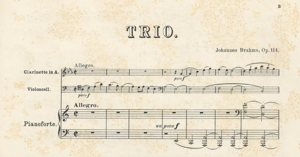
This website of the Brahms Institute in Lübeck (Germany) currently (2016) contains 42,000 images spreading across autograph manuscripts, early prints, photographs, concert programs, and personal documentation.
Chopin's First Editions Online (CFEO)
Website: http://www.cfeo.org.uk/about/description.html
This composite website, based at Royal Holloway College, London, serves more than 5,500 page images of early editions of Chopin's music. The project is headed by John Rink, with the collaboration of numerous holding institutions including the Bibliiothèque Nationale de France (Paris), the Bodleian Library (Oxford), the British Library (London), the University of Chicago, and the Chopin Institute (Warsaw). The separate listings below also function independently. The aim of the umbrella site is to facilitate close examination of sources in diverse collections and to coordinate early prints of Chopin's music with the Annotated Catalogue of Chopin's First Editions.
Jagiellonian Digital Library: Chopin holdings
Website: http://jbc.bj.uj.edu.pl/dlibra/collectiondescription?dirids=186
Featuring 17 volumes of Chopin's piano music at Jagiellonian Library in Kraków. The sites are under development.
University of Chicago: Chopin Early Editions
Website: http://chopin.lib.uchicago.edu
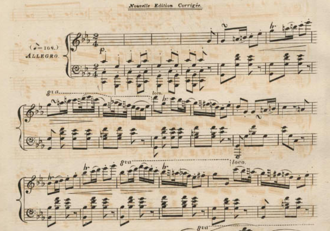
For an easy-to-consult listing of printed music by Chopin in the University of Chicago library, it is hard to surpass the Chopin Online Chopin Online Catalog. Citations are based on the library's shelfmarks, but since the music is digitized, users will have no difficulty in locating what they seek.
Online Chopin Variorum Editions (OCVE)
Website: http://www.ocve.org.uk/index.html
Not so much a single project as a whole constellation of Chopin-related research projects, John Rink's Chopin Variorum investigates such things as the work concept in Chopin's time and provides an annotated catalogue of first editions. Both are coordinated with The Complete Chopin: A New Critical Edition, printed in London (2004).
Georg Friedrich Händels Werke]
The Handel Gesellschaft edition of the composer's works (105 titles) was published by Breitkopf & Härtel between 1885 and 1902. It contains all but a few of the major works known today, sometimes with variants of arias or choruses that were excluded in later editions. [For earlier sources see "Lully" below.]
Franz Liszt Musikalische Werke
Website: http://daten.digitale-sammlungen.de/~db/ausgaben/uni_ausgabe.html?projekt=1193812455
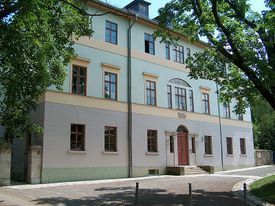
This collected edition of Franz Liszt's works (35 volumes) was published by Breitkopf & Härtel, Leipzig. Although the first volume appeared in 1870, the others appeared between 1900 and 1936. Symphonies, symphonic poems, works for piano and orchestra, Liszt's music criticism, and little-known arrangements are included. The picture at the left shows Liszt's residence from 1848 to 1861, while he was director of court music. Today the Liszt Haus serves as a museum.
Jean-Baptiste Lully Collection (University of North Texas)
Website: http://www.library.unt.edu/collections/music/lully
Twenty-six scores of Lully's best-known dramatic settings are preserved in the music collection of the University of North Texas (Denton TX). Together with arrangements and variants of works by Lully in the 182 holdings of the Virtual Rare Book Room a broad basis for study of Lully's milieu is available here. Dates of works in the broader collection extend to late in the nineteenth century. Among holdings that fall outside this description are a 1743 print of Handel's Alexander's Feast, the first printed edition (1767) of Handel's Messiah, the first version of George Grove's 4-volume Dictionary of Music and Musicians, London, 1879–90, and Girolamo Gigli's original libretto (1689) for an opera called La fede ne' tradimenti, which enjoyed many settings in Italy.
Felix Mendelssohn Bartoldys Werke
This collected edition (162 titles) of Mendelssohn's music was issued by Breitkopf & Härtel. String quartets, quintets, chamber music for clarinet and basset horn, piano trios, works for piano and cello, a fantasy on the Irish song "The last rose of summer" (Op. 15) and many other little-known pieces of chamber music can be found here together with more familiar fare.
Neue Mozart Ausgabe Online
Website: http://dme.mozarteum.at/DME/nma/start.php?l=4
A fully digitized version of the Neue Mozart Ausgabe has been available online since 2006. Series and volumes follow exactly the Bärenreiter print. All elements of the printed exemplars (table of contents, score, critical report) are present. Letters, documents, and libretti will be added by the Digital Mozart Edition at the Mozarteum, Salzburg, in cooperation with the Packard Humanities Institute. This is the only recent collected edition of the works by a major composer currently offered online.
Ignaz Pleyel Early Editions
Website: http://digital.lib.uiowa.edu/pleyel
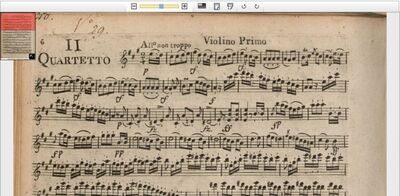
The late musicologist Rita Benton made an exhaustive study of Pleyel's editions (c. 1800) of the early string quartet literature. In the library named after her, more than 200 early editions and manuscripts give some sense of the scope of Pleyel's career as both a composer and a music publisher in the era of Haydn, Boccherini, and other notable composers of chamber music. In editions of chamber music for strings Pleyel also brought out piano pedagogy books and piano trios.
Franz Schuberts Werke
Website: http://daten.digitale-sammlungen.de/~db/ausgaben/uni_ausgabe.html?projekt=1259652551
The collected works of Franz Schubert, as published by Breitkopf & Härtel, Leipzig, 1884-1892. 53 volumes, including symphonic and piano works, choral works, theater pieces, piano four-hands arrangements, and song cycles.
Robert Schumann Werke
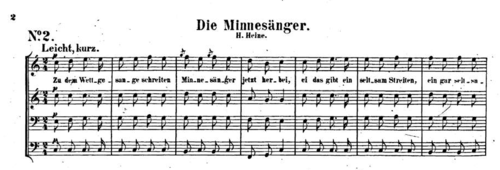
The works as edited by Clara Schumann and others. This series was published in Leipzig by Breitkoft & Härtrel between 1881 and 1893. The illustration shows the start of "Die Minnesänger" for four male voices, No. 2 from Schumann's Sechs Lieder.
Tomás Luis de Victoria
Website: http://www.tomasluisvictoria.es/en/content/center
The Centro d' Estusios Tomás Luis de Victoria (CEV) is a comprehensive one aimed at promoting greater familiarity with the music of the noted Spanish composer (1548-1611). To this end it offers a catalog and numerous reprints together with notices of events, podcasts, and a biography of the composer. Its website is optimized for mobile access (via smartphones and tablets).
The bibliographical apparatus is very clearly organized, and the CEV's integration of its diverse resources is a model of sensible organization. Since nearly all of Victoria's music is sacred vocal, the liturgical positioning of individual works is indicated. Links to texts, translations, and sources are fully covered. Some modern editions are credited to CPDL and IMSLP (in most cases relying on Pedrell's edition (Thomae Ludovici Victoria Abulensis Opera omnia), Leipzig 1902–13), while others are newly edited. It has links for discussion forums, facsimiles, monographs, and a discograhy.
Victoria entered musical life as a chorister in Ávila Cathedral, received his formal education and early professional experience in Rome, and upon his return to Spain (1577) entered the service of Dowager Empress Maria of Austria (daughter of Charles V, wife of Maximilian II, and mother of two other emperors) in Madrid. A priest, Victoria preferred convent life and declined several invitations to assume a more conspicuous post. His works consist mainly of masses (including parodies), motets (some sorrowful), Magnificats, Lamentations for Holy Week, and other species of liturgical music. Their performance attracted many listeners to the empress's convent.
By Collection
Monuments of German Music, Series 1
This 53-volume anthology of German music of the seventeenth and eighteenth centuries greatly increased familiarity with the music of Buxtehude, Telemann, J. Ch. F. Bach, Melchior Franck, Hasse, Scheidt, Stoltzer, and many others.
Monuments of German Music, Series 2 (Bavaria)
The second series of this well-known anthology, focused on Bavaria, emphasizes music associated with the Bavarian courts resident in Munich and (through composers such as Dell'Abaco) in exile in Brussels. Also represented are Stamitz, Haßler, Pachelbel, Pez, Steffani, Toeschi, and others. Published in 36 volumes (1901–1926).
Duben Collection Database Search
Website: http://www2.musik.uu.se/duben/Duben.php
The Düben Collection Database Catalogue is a digitised catalogue presenting meta-data and scanned facsimiles of the Düben Collection, a large and important collection of musical manuscripts and prints from the 17th and early 18th centuries. The compilation of the catalogue was initiated in 1987 and is a collaboration between Uppsala University and the University of Rochester.
Eastman School of Music/Sibley Music Library
Website: https://urresearch.rochester.edu/viewInstitutionalCollection.action?collectionId=63

The constantly growing digital collection of the Sibley School of Music is heterogeneous. It includes printed scores, manuscripts, and books—all of them in the public domain under U.S. copyright law. A large percentage of its holdings (currently 22,500 items) come from 19th- and early 20th-century America. Many items are unique.
Gaspari Online (Bologna Conservatory)
Website: http://www.bibliotecamusica.it/cmbm/tools/pro_dig.asp
The Gaspari Catalogue of holdings in the Bologna Conservatory is a resource well known to students of Italian music. It describes the heterogeneous holdings of what is now formally called the Museo Internazionale e Biblioteca della Musica di Bologna (the International Museum and Music Library of Bologna). Composed of multiple underlying libraries and collections, its holdings range from early liturgical sources to music of the twentieth century, from correspondence to musical instruments from earlier centuries to 4,000+ opera libretti (the Corago Project), most searchable from this start site. Under the same umbrella one can also find c. 400 portraits of musicians, mainly from nineteenth-century lithographs (as with Maria Malibran, shown at the right) and the voluminous eighteenth-century correspondence of Giambattista Martini, also edited in book form by Anne Schnoebelen.
Two collections--Corago (see under Libretti) and Ritratti di Musicisti (Musicians' Portraits: see under Image Banks/Iconoteca)--are listed separately.
Printed Music in the Bavarian State Library

This collection of 3,379 titles includes a large number of works from the eighteenth and early nineteenth centuries (Krebs, Türk, Danzi, Mendelssohn, and others). It also holds impressive early printed music, including Pierre Attaignant's seminal collection of Trente e six chansons musicales (1530), use of which is restricted to study. Clemens non Papa, Croce, Lassus, Rore, Vecchi, Wert, and Willaert are much in evidence, as are the publications of Pierre Phalèse the Elder.
Printed Music in the Prussian State Library
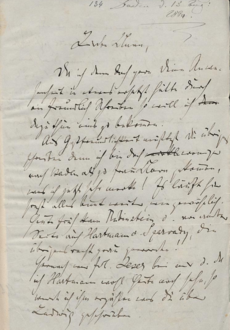
Among its treasures, the Prussian State Library in Berlin has recently uploaded (2016) 8,445 digital reprints covering a wide array of musical genres. Some obvious categories are music theory (including obscure tutors on harmony and counterpoint), folk music circulating in earlier centuries, musical dictionaries, comic operas, , hymns, psalm settings, spiritual songs, and a vast number of letters by composers. Our illustration shows one from Brahms, writing in Baden, to Clara Schumann, 15 August 1864. The exchange starts in 1855 and continues into the early 1890s. The date range is from the early sixteenth century to the early twentieth.
By Publisher
Nicolas Du Chemin: Chansons Nouvelles
Website: http://ricercar.cesr.univ-tours.fr/3-programmes/EMN/Duchemin/index.htm
Sixteen sets of books published by Parisian printer Nicolas Du Chemin between 1549 and 1568 are reproduced here in a collection that includes facsimiles, modern transcriptions, scholarly commentaries, and tools for research.
Sheet Music Collections and Miscellanies
University of Michigan list of sheet music collections
Website: http://guides.lib.umich.edu/c.php?g=282790&p=1884296
Sheet music denotes single pieces of music that were published prolifically in the US in parallel with the rise of the recording industry. Most items are for piano and voice, but popular songs were often transposed for several ranges. Many large collections survive in university libraries, and among them several are fully digitized. Redundancies in single-title listings are common, but in general each collection represents nearby publishers disproportionately.
The Sheet Music Cconsortium: A one-stop shop for cross-collection access
Website: http://digital2.library.ucla.edu/sheetmusic
This comprehensive search across many collections is made available by UCLA. The aggregate number of listings is truly staggering. Across 53 linked, indexed collections, we found close to 300,000 listings (April 2023). Most listed collections are in the US, but some inclusions come from the United Kingdom and Australia. This large aggregate corpus produces many redundancies, but sometimes the minute differences (or year, place, or cover art) are very informative. A search for Carrie Jacobs-Bond's "Perfect Day" produced almost 9,500 potential matches, with the earliest examples coming from 1910.
African American Sheet Music
Website: http://library.brown.edu/cds/sheetmusic/afam/index.html
The browsing facility for Brown University's online collection (1454 titles) is very easy to use. Some of the material (e.g. "Music Theater, 1865–1910) is also accessible at the Library of Congress "American Memory" website. Some uses are restricted.
American Sacred Music
This collection of digitized hymnals from the Mills College Music Library recalls the college's origins in 1851, on the heels of the California Gold Rush. The dates of the publications extend from 1833 to 1917.
American Vernacular Music Manuscripts
Website: https://archive.org/details/americanmusicmanuscripts
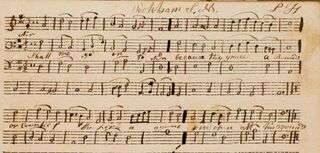
Murfreesboro, TN, the home of what is now called Middle Tennessee University, was a nexus of popular music-making before jazz established itself in Nashville. This collection of manuscript resources (c. 1730–1910) is full of miscellany but also offers documentation not available anywhere else. For most users the archive.org link given above will be more accessible than the university's Center for Popular Music server. To date 333 shelfmarks (many of them collections) have been uploaded. George Allen's "Reels, Clogs, Hornpipes, Jigs" is representative.
Archive of Popular American Music
Website: http://digital.library.ucla.edu/apam
UCLA's stupendous collection of popular music (450,000 items) is searchable by name, title, date, and cover art subject and several other categories of information. Covers only are scanned.
The Drs. Whitby Music Collection
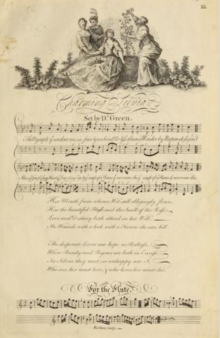
Website: https://archive.org/details/whitbymusic?&sort=-downloads&page=3
This Canadian collection (1,339 items) at the University of Western Ontario (Waterloo) consists mainly of instrumental music from the nineteenth century. Titles in music theory and pedagogy are abundant. Some unusual anthologies including George Bickham's Musical Entertainer (1740), a collection of arias with obbligato flute parts, are found among its eighteenth-century holdings.
Historic American Sheet Music HASM (Duke University)
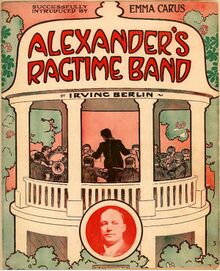
Website: http://library.duke.edu/digitalcollections/hasm
Duke University's Historic American Sheet Music collection (3,000+ titles) spans the time-period 1850–1920. It includes a song-lyrics index, has tabbed browsing, and provides helpful background on the sheet-music printing industry in the US. HASM is also linked to the Library of Congress's American Memory project. It has particular value for matching references in early film music, ragtime, and piano-rolls, that is for repertories that were known principally by ear. Searchable by subject, instrumentation, and illustrator as well as more usual parameters.
Irish Sheet Music Archives
Website: http://irishsheetmusicarchives.com/About-Us.htm
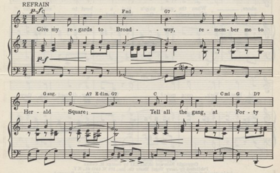
The Irish Sheet Music Archives website is the home of the online sheet music collections found in the Ward Irish Music Archives located in Milwaukee, Wisconsin. It enables searching, viewing, and in the majority of cases downloading its more than 5,000 scores of Irish and Irish-American sheet music. Those wishing to locate scores in the public domain (and therefore downloadable) are best off starting here, where the copyright status, instrumentation, and other details are clearly shown. Specialty subsections contain songs by George M. Cohan (1878-1942) and Harry Lauder (1870-1950), bagpipe pieces arranged for piano, and songs from the first world war.
Lester Levy Sheet Music Collection
Website: http://levysheetmusic.mse.jhu.edu
The Lester S. Levy Sheet Music Collection, based at Johns Hopkins University, contains 29,000 pieces (1780–1980). It is rich in popular music from the nineteenth century, particularly surrounding the years of military conflicts—the war of 1812, the Civil War (1861-65), and the First World War (1914–18). The collector wrote several books on specific subjects within the collection.
Lilly Library Sheet Music Collections
Website: http://www.indiana.edu/~liblilly/collections/sheetmusic.shtml

These collections at Indiana University are very large. Collectively they hold more than 275,000 pieces of American sheet music. Available materials can be searched with the In Harmony search page.
Music for the Nation: American Sheet Music 1870-1885
Website: http://www.loc.gov/collection/american-sheet-music-1870-to-1885/about-this-collection
This Library of Congress collection comes from copyright registrations. It is complemented by sheet-music repertories for the years 1820–1860 and the Civil War years that immediately followed.
Netherlands Radio Music Library
Website: http://www.muziekschatten.nl/action/category?id=1&order=composer&letterPage=v
This treasury of the Netherlands Radio Music Library in Hilversum contains nearly 5000 scores of classical, choral, light, and popular music (including manuscripts). Users can download and print PDF files from the Flash window. They are invited to upload their own sound recordings of the music they downloaded. Most "classical" works are by Dutch composers, and some are arrangements of scores originating elsewhere. Popular sheet music is chiefly from the late nineteenth and earlier twentieth centuries. Since the search pages are only in Dutch, a good starting point is the composer index.
Nineteenth-Century American Sheet Music (NcASM)
Website: http://www2.lib.unc.edu/dc/sheetmusic/index.html
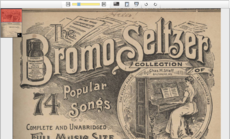
This University of North Carolina website holds almost 7500 digitized pieces from 1815 (music from the opera The Devil's Bridge to 1945 (an edition of Chopin's Polonaise Op. 53) as well as letters pertinent to holdings. The online catalogue search offers many options. Holdings include songs with piano accompaniment to duets, trios, and four-part glees.
Nineteenth-Century California Sheet Music
Website: http://people.ischool.berkeley.edu/~mkduggan/neh.html
The original holdings consisted of 2700 pieces published in California between 1852 and 1900. A further collection of 700 pieces was added in 2007. The project is maintained at the University of California, Berkeley. The pieces represent a wide range of Western US and native American traditions. Some sound, video, and MIDI files are also available.
St. Petersburg Score Collection
Website: http://www.jewishmusic-asjm.org/database-the-st-petersburg-score-collection.html
This collection located in St. Petersburg is maintained by the American Society for Jewish Music. Many published titles are in German and Russian. Publication took place in Kiev, New York, and several places between them.
University of North Carolina (UNC)
Website: https://archive.org/details/uncmus?&sort=-downloads&page=2
The UNC collection (3000+ items) represents categories of popular and religious music in use in the South Central US between 1880 and 1920. In addition, excerpts and short scores for operatic material and pedagogical material make up almost half the holdings. Robert Planquette's three-act comic opera Les Cloches de Corneville is currently the most viewed item. Beyond scans, this recourse offers 10 other download formats including epub, Kindle, Daisy (for print-disabled users), and many more.
University of Toronto Music Faculty Collection
Website: https://archive.org/details/facultyofmusic
The University of Toronto Music Faculty digitization project makes available more than 4,500 items reflecting, overall, the distribution of topical interests relating to music in Canada. The collection is evenly divided between sheet music and now-rare books. The pedagogical emphasis is pronounced. One of the most heavily used items is Theodore F. Freylinghuysen's Tonic Sol-Fa Music Reader (1890), published under his pseudonym Seward.
World War I Sheet Music
Website: http://www.loc.gov/collection/world-war-i-sheet-music/about-this-collection
This collection at the Library of Congress contains almost 14,000 items, all of which are fully digitized. The materials include not only conventional prints but also privately published and unpublished (amateur) material.
Yiddish Sheet Music
Website: http://library.brown.edu/cds/sheetmusic/yiddish/about.html
This special collection at Brown University contains roughly 2,000 items. Much of it represents the Yiddish-language musical stage in Russia around around 1900. Holdings include works by Bores Thomashefsky, the grandfather of Michael Tilson Thomas.
Digitized Music Manuscripts
Digitized collections of unpublished materials.
By Composer
Ludwig van Beethoven: Beethoven-Haus, Bonn
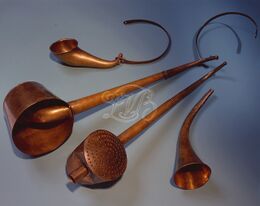
Website: http://www.beethoven-haus-bonn.de/sixcms/detail.php?template=startseite_digitales_archiv_de
The digital archive at the Beethoven-Haus, Bonn, contains manuscripts, sketches, letters, pictures, sample sound recordings, and much else. Beethoven lived here, and the physical museum also houses his instrument collection. A recently funded project involving the Beethoven-Haus and the Musikhochschule in Detmold will develop an ambitious "Beethoven Werkstaat" project taking viewers through the development of individual works by way of sketches and editions.
Beethoven Autographs Online
Website: http://www.bu.edu/beethovencenter/beethoven-autographs-online
Boston University's Beethoven Center offers several tools for Beethoven scholars and performers. Among them Beethoven Autographs Online is a one-stop shop for rare materials ranging from fragments, sketches, and cadenzas to complete manuscripts of full scores from libraries and private collections across Europe and North America. Its reference system conflates diverse work-numbering schemes into one easily searchable whole.
Beethovens Werkstatt (Beethoven's Workshop)
Website: http://beethovens-werkstatt.de/demo/index.html
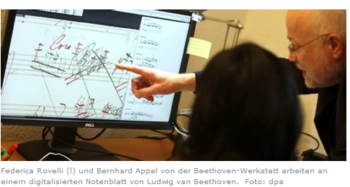
The ambitious Beethovens Werkstatt project, officially launched in 2014, will between now and 2030 reconstruct (with images and critical notes) the path of development of Beethoven's works from inception to completion. This project is based on the composer's sketch books, which in the digital version are to be carefully annotated with the help of the Music Encoding Initiative [MEI], a markup language for the encoding of musical sources facilitating their citation in critical editions. Bernhard Apel (Beethoven-Haus, Bonn) and Joachim Veit (Musikwissenschaftliches Institut, Detmold/Padlerborn) are the project directors. Johannes Kepper (Edirom project) is centrally involved in the technical development of both Werkstatt and MEI. The link above shows a prototype browser for viewing both manuscript iterations and modern notation for variants in the first movement of Beethoven's C-Minor Piano Sonata Op. 111 in Variants 14–17 (Beethoven-Haus BH 71).
Johannes Brahms Institute
Website: http://www.brahms-institut.de/web/bihl_digital/autographe.html
The Brahms Institute in Lübeck hosts a composite site for autographs, early editions, letters, and other kinds of documentation associated with Brahms. In this last category are such things as concert programs and fragments of music, drawings, and photographs of and by his associates.
See also the Johannes Brahms organization site.
Web Archive Anton Bruckner
Website: http://www.bruckner-online.at
The multi-faceted Anton Brucker web archive at the Austrian Academy of Sciences contains 26,000 images of the composer's autographs and early copies plus 6000 images of early prints. An associated database cites c. 10,000 works and related literature. The project is managed by Robert Klugseder. Online editions prepared with Edirom are in preparation.
John Cage Living Archive
Website: http://exhibitions.nypl.org/johncage/manuscripts
The New York Public Library for the Performing Arts, in collaboration with the John Cage Trust and the publisher C. F. Peters, hosts this sampler of Cage's physically diverse manuscripts. At a glance the reader can see the broad diversity of Cage's approaches--arithmetical, schematic, electronic, and aleatoric. A search engine has filters for video, manuscript, and ephemeral material. Video contributions of performances of Cage's music are actively sought via this form.
The Aaron Copland Collection (Library of Congress)
Website: http://www.loc.gov/collection/aaron-copland/about-this-collection
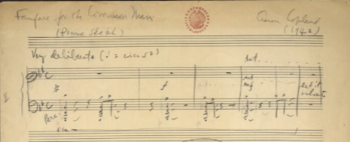
The Aaron Copland Collection, available at the Library of Congress, is an exceedingly rich one that contains every imaginable kind of evidence of the composer's long life (1900–1990)—manuscripts, sketches, typescripts for talks, personal photographs (roughly 5,000 of them), childhood mementos, and letters. Apart from photos, 981 other items can be found here.
Materials pertaining to Edvard Grieg
Website: http://bergenbibliotek.no/digitale-samlinger/grieg/english
Shortly before his death Edvard Grieg (1843-1907) arranged for the donation of all his music, letters, and related materials to the Bergen Public Library. The origins of the digitization project date back to 1993, the 150th anniversary of Grieg's birth. Grieg had a deep interest in recording technologies of his time. Starting in 1903 he made nine recordings of his music (on 78s), player-piano rolls from live-performance (Ludwig Hupfeld's Phonola and Welte-Mignon), and the Aeolian Company. For the last he suggested tempo mappings.
Handel's Messiah and other virtual "page-turners" from the British Library
Websites: See below.
The British Library's Virtual Books website contains a number of important manuscripts, the folios of which can be "turned" by the user. In addition to the autograph score of Handel's Messiah, "Sumer is icumen in", the Old Hall manuscript, the manuscript for Book II of J. S. Bach's Well Tempered Clavier, a Purcell anthem for the coronation (1685) of James II, sketches for Beethoven's Sixth ("Pastoral") Symphony, Elgar's "Enigma" Variations, and Mozart's musical diary (Zweig MS 63) are set up in similar fashion. A listing of other viewable musical works can be found here.
Handel autographs and other music manuscripts
The British Library completed the digitization of 38 Handel autograph manuscripts in 2016. They are accessed through the Library's "catalogs, archives, and manuscripts" website, where the user may limit the date range (slider at the bottom of the form). An author search for "Handel autographs" (currently yielding 168 hits) picks up unrelated miscellany, while a search for Handel alone produces a list of 103 titles. Items listed range from definitive scores of myriad operas, oratorios, cantatas, and other vocal and choral works to miscellaneous pieces (especially arias) collected by John Christopher Smith, Handel's copyist.
Among other composers represented, we find 311 manuscripts associated with the Bach family (52). Searches for other composers yield these figures: Thomas Arne (57), Giovanni Bononcini (58), William Boyce (115), William Byrd (141), Joseph Haydn (239), Orlando de Lassus (48), Benedetto Marcello (52), Wolfgang Amadeus Mozart (297), Pierluigi Palestrina (99), Giovanni Paisiello (84), Henry Purcell (233), and Alessandro Scarlatti (84), Franz Schubert (95), and William Walton (374).
The Handel autographs all have live links (2016), while many other listings currently contain catalog information. Holdings responding to composer searches may also yield correspondence, deeds, and other personal papers.
Michael Haydn Manuscripts
Website: http://daten.digitale-sammlungen.de/~db/ausgaben/uni_ausgabe.html?projekt=1384445203
181 comprehensive titles from the Bavarian State Library. The heavy emphasis on liturgical music reflects Haydn's lifetime involvement in church music, mainly in Salzburg and Vienna.
Gustav Mahler Autograph Manuscripts
Website: http://daten.digitale-sammlungen.de/~db/ausgaben/uni_ausgabe.html?projekt=1384445807
30 volumes of autograph manuscripts by Gustav Mahler are housed in the Bavarian State Library (Munich). Offerings include Das Knaben Wunderhorn, sketches for three symphonies, and Mahler's correspondence with Emil Hertzka.
Felix Mendelssohn Materials (Library of Congress)
Website: http://www.loc.gov/collections/felix-mendelssohn
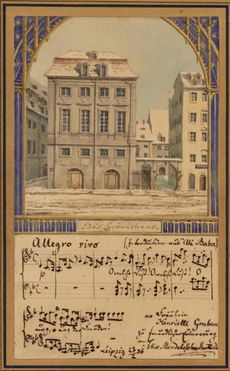
The Library of Congress holds a collection of miscellaneous Mendelssohn memorabilia that includes letters, lithographs, printed, and manuscript music. The illustration here shows a watercolor of the Gewandhaus, Leipzig, by Mendelssohn from the scrapbook of Henriette Grabau, a singer who appeared there when Mendelssohn conducted in 1836. The musical except beneath it comes from the Cherubini's opera Ali Baba. Manuscripts of the Lieder ohne Wörte and the Octet, as well as drawings from his travels in Italy, are among the holdings.
Carl Orff Autograph Manuscripts
Website: http://daten.digitale-sammlungen.de/~db/ausgaben/uni_ausgabe.html?projekt=1384446061&l=de
This collection of manuscript materials (91 titles) documents the musical career of Carl Orff (1895–1982). It includes, Lieder, stage works, modern arrangements of Monteverdi operas, and other materials. Because of continuing copyright restrictions, many items can be consulted only on site in the Bavarian State Library. Nonetheless the detailed listing is valuable in documenting the range of Orff's interests and activities.
Max Reger Autograph Manuscripts
Website: http://daten.digitale-sammlungen.de/~db/ausgaben/uni_ausgabe.html?projekt=1384445879&l=de
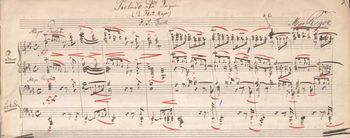
The music of Max Reger (1873–1916) occupies a unique place in the keyboard repertory of its time. His organ works are better known than his other music—concertos, Lieder, choral works, and a clarinet quintet. Forty titles are viewable here.
Cipriano de Rore: Illuminated Choirbook from the Court of Albrecht V
Website: http://daten.digitale-sammlungen.de/~db/0010/bsb00103729/images/index.html
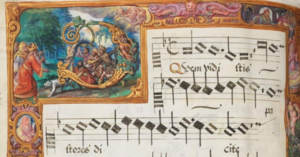
The brilliant colors and generous proportions of this choirbook, illuminated by Hans Mielich (1516-1573) for the Court of Albrecht V of Bavaria are stunning to behold. It is dated 1559. The books includes portraits of the duke, Duchess Anna, and of the composer. Rore (c. 1515-1565) was mainly active in Italy. He moved to Munich from Ferrara in the summer of 1559, which suggests that the bulk of the motets found here were composed prior to his arrival. Two volumes of his motets had been published in Venice in the 1540s. A further one followed in 1563.
The Arnold Schönberg Center
Website: http://www.schoenberg.at/index.php/en
The Arnold Schönberg Center in Vienna holds a cornucopia of Schönberg memorabilia that extends to film footage of the composer's real-world experiences such as being briefly employed as an auto salesman, his "contacts" list, and personal photographs, provides an online list of works, biographical sources, and information on performing rites. Autograph fair copies, sketches and drafts of Schönberg's compositions; autograph manuscripts and other primary sources for Schönberg’s theoretical writings and literary works; writings on musical pedagogy, as well as lectures and teaching materials; early printed copies of Schönberg’s works, including autograph annotations, performance instructions, and revisions; personal documents; Schönberg’s complete library; programs, reviews, posters; photographs and audiovisual documents all form part of the collection.
Schubert Online
Website: http://www.schubert-online.at

Schubert Online offers combined access to a total of 636 autograph scores, letters, and other documentation on Schubert. Much of the work was facilitated by the Vienna Science and Technology Fund [WWTF or Wiener Wissenschafts-, Forschungs- und Technologiefonds]. Digitized holdings come from Vienna's City Hall [Rathaus], the Austrian National Library, the State Library of Berlin, and the National Library of Norway, with intellectual contributions from the Music and Psychology program in Cologne and the Musicology Institute at the University of Vienna. Full-text search is supported for the letters. Deutsch Numbers are used to identify the manuscripts.
Strauss Online
Website: http://www.digital.wienbibliothek.at/nav/classification/301934
The music of three Johanns (father, son, uncle), one Josef, and one Eduard is represented at this website based at the city library of Vienna. More than 300 works are available here. Almost 200 of them are by Johann Strauss the younger, the waltz king. A few sketches, operettas, marches et al. are included. The minor Strausses composed polkas as well as other short instrumental pieces. Eduard's Theorie der Musik from c. 1845-50 can be downloaded here. An online catalogue of the library's printed works is available here.
Richard Strauss: Musical Autographs
Website: http://daten.digitale-sammlungen.de/~db/ausgaben/uni_ausgabe.html?projekt=1384446235
Among these 84 titles are numerous sketches, fragmentary compositions, and Lieder. The originals are held in the Bavarian State Library.
Verdi Online
Website: http://www.verdi.san.beniculturali.it/verdi/?lang=it
The Verdi Online collaboration hosts diverse materials--libretti, letters, portraits and figurines, bibliography, discography, and large quantites of background information about places and people associated with Giuseppe Verdi.
Georg Josef Vogler Music Manuscripts
Abbe Vogler (1749–1814) left a substantial collection of manuscripts (75 titles) that includes chamber and sacred music, concertos and symphonies, plus several items that relate to his opera Castor et Pollux.
Richard Wagner: Notebooks, music manuscripts, and correspondence
This collection of unpublished materials from the archive of the Bavarian State Opera brings Wagner's goals and working habits into our midst. Under 170 rubrics it documents the composer's movements, collaborators, and evolving ideas about music and role of music in society. They also give a more rounded view of his range of interests than many published accounts.
Robert Ward Papers
Website: https://archives.lib.duke.edu/catalog/wardrobert
Robert Ward was an American composer primarily of operas, instrumental works, and symphonic choral works. He won the 1962 Pulitzer Prize in Music for his opera, The Crucible, which remains his best-known work. His exceptionally long life (1910-2012) enabled him to compose for 95 years! Ward studied at the Eastman School of Music in the 1930s and subsequently taught at Columbia University, North arolina School of the Arts, and Duke University.
Manuscripts of Ermanno Wolf-Ferrari
Website: http://daten.digitale-sammlungen.de/~db/ausgaben/uni_ausgabe.html?projekt=1384446335&l=de
Ermanno Wolf-Ferrari (1876–1948) followed the path of aspiring students of his time in examining the details of earlier composers' practices. This collection of his manuscripts (175 titles) includes transcriptions of keyboard works by J. S. Bach, sketches of operas, concertos, symphonies, comic operas, a passion, sonatas, string quartets, and other chamber music.
By Collection
Corpus Musicae Ottomanicae (CMO)
Website: https://www.uni-muenster.de/CMO-Edition/cmo/cmo.html
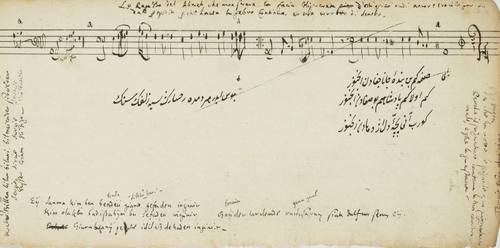
This recently announced project (2020) to digitize and transcribe manuscripts of Middle Eastern Music, named the Corpus Musicae Ottomanicae (CMO), concentrates on musical materials originating in the Middle East in the seventeenth through nineteenth centuries. A digital critical edition based on the collection is being prepared under the auspices of the Institute for Arabic and Islamic Studies at the Westphalian University in Münster, DE. Detailing of musical performance practices is an intended area of focus. ʿAlī Ufuḳī, sold to the sultan's court in Istanbul as a slave in the seventeenth century, was a rapt student of culture who gathered vast quantities of information about language and customs during his many years at court. He transliterated texts and notated melodies provide offer glimpses of style ad substance that are rare, for in general music was not notated. Custom required the music to be read from right to left.
Digital Collections in the Berlin State Library
Website: http://digital.staatsbibliothek-berlin.de/suche/?DC=musik
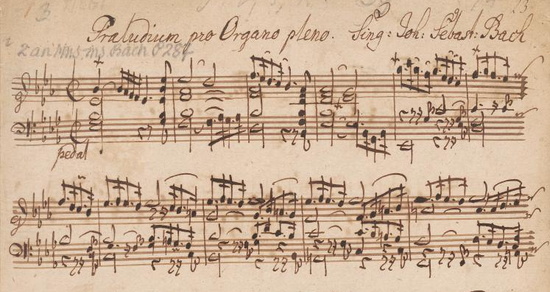
The 7,348 digitized music items at the Berlin State Library website include manuscripts, prints, libretti, poetic texts for Lieder, and much else. Of interest to Beethoven scholars are the composer's conversation books (1820, 1825, 1826). Other offerings include writings by and about https://en.wikipedia.org/wiki/Richard_Wagner Richard Wagner}; music in manuscript by Franz Liszt; letters to Clara Schumann by Johannes Brahms (and many others); prints, manuscript, and letters by Felix Mendelssohn; and copious amounts of eighteenth-century music, some of it in nineteenth-century manuscript copies.
Digitized Manuscripts in the University and Regional Library Darmstadt
Among the 2,909 music manuscripts in the music section of this heterogeneous collection, those of Christoph Graupner play a major role. (See the Graupner entry under Thematic Catalogues.) Most of the items come from the long eighteenth century, when they sustained the life of the court and the city. Other composers of note include Attilio Ariosti, Jo. Chr. Bach, Georg Benda, Jo. Friedrich Fasch, Jo. Gottlied Graun, Jo. David Heinichen, G. Ph. Telemann, Abbé G. J. Vogler, and several nineteenth-century masters.
Rare Music Manuscripts in the British Library
Website: http://www.bl.uk/onlinegallery/onlineex/musicmanu
See the Old Hall manuscript, Purcell's coronation anthem for James II, an excerpt from Handel's Messiah, Bach's autograph for Book Two of the Well-Tempered Clavier, Mozart's thematic catalogue of his composition, Beethoven's sketches for the Sixth Symphony ("Pastoral"), and much else. (Music manscripts make up just one part of the holdings viewable at this portal.)
E-codices: The Virtual Manuscript Library of Switzerland
Website: http://www.e-codices.unifr.ch/en
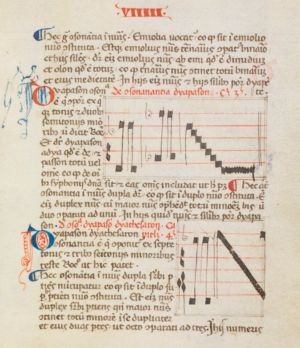
In many ways e-codices, the Virtual Manuscript Library of Switzerland, is an unsurpassed example of maximal access to fundamental but rarely seen sources. Currently serving almost 1,400 parchments and manuscripts, its online existence began in 2007. Its value to musicology owes partly to a tight coupling between early histories of music and the sources on which these accounts were often based. The digital apparatus is very clearly articulated, and it search by many rubrics is possible. Access to color images of the materials long known only from running-text summaries of them enables users to pose new questions of interpretation. Users can construct new juxtapositions and concatenations of source details in relationships that could not previously be explored. An annotation tool enables users to highlight pertinent findings. e-codices is based on like-named software, which holds the distinction of running equally well on mobile and non-mobile platforms. An author list is available here.
Among its many riches to be found are these rare items:
- Writings of Hucbaldus (840–930) from the Benedictine abbey at Einsiedeln.
- The Ars contrapunctus of Philippe de Vitry (1291–1361) from the Benedictine abbey at Einsiedeln.
- Fragment (in Latin) of a writing by Moses Maimonides (1135–1204).
Recent software enhancements and links for the e-codices newsletter are available. A tablet viewer also exists.
Early Keyboard Manuscripts at Yale University
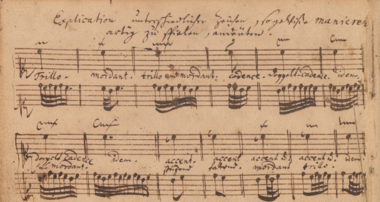
The Beinecke Library at Yale University holds substantial collections of music manuscripts, not all of it digitized to date. Highlights include not only notebooks for members of the Bach family but also chorale settings, manuscripts by Alessandro Scarlatti, seventeenth-century English music for instrumental ensembles, and transcriptions by Ezra Pound. The Orbis catalogue linked includes a wide range of items.
Fragmentarium
Website: https://fragmentarium.ms
Fragmentarium is not so much a single project as a global effort in digital restoration to locate, identify, and, where possible enhance nominally lost fragments of medieval manuscripts. The material is not exclusively musical, but since music was an adjunct to medieval manuscripts, Fragmentarium's availability to music scholars is an important resource. Fragmentarium is based at the Universiuty of Fribourg (CH) and is directed by Christoph Früeler. As of May 2022 it included nearly 3,000 items.
Gaffurius Codices Online
Website: https://www.gaffurius-codices.ch/s/portal/page/home
Franchinus Gaffurius (1451–1522) was a noted music theorist whose compositions, largely associated with his tenure as maestro di cappella at the Milan Cathedral, are little known. The Gaffurius Codices Online is devoted to inventorying the four Libroni containing the sacred vocal music he composed at this time, which coincided with the peak of Milan's Sforza rulers. (Leonardo da Vinci enjoyed a great deal of patronage from the Sforza family.) Gaffurius was a near contemporary of Josquin des Prez. The chief focus of this project is on the motets contained in the four large volumes. The contents will be captured in IIIF images suitable for sophisticated uses in a digital environment. A database containing important metadata will be developed in conjunction with the imaging. A digital critical edition is intended at a later time. the Gaffurius project is being developed by the Schola Cantorum Basiliensis in conjunction with the Swiss National Science Foundation.
Handrit: Historical (Music) Manuscripts from Iceland
Website: http://handrit.is/en/Handrit
This collection from the National and University Library, Reykjavik, contains historical manuscripts from Iceland. To find music, select Browse, Keywords, Arts, Music. Sources range from the 15th through 19th centuries.
Integrated Database for Early Music (IDEM)
Website: http://www.idemdatabase.org/alamire
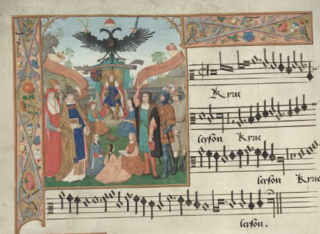
The Integrated Database for Early Music (IDEM), seated in the Musicology Research Unit (Katholieke Universiteit, Leuven), is an interdisciplinary, multifaceted database of manuscripts and printed books. Under the auspices of the Alamire Foundation, an international center for the study of music in the Low Countries, IDEM focuses on the musical heritage of these countries from the early Middle Ages until 1800.
The IDEM collection of digital images is coordinated with a central database of primary sources. Images are digitized by the Alamire Digital Lab, which provides high-technology photography at its Centre in Leuven, where state-of-the-art equipment allows musical sources to be photographed following strict quality requirements.
The Juilliard Manuscript Collection
Website: http://juilliardmanuscriptcollection.org/composers
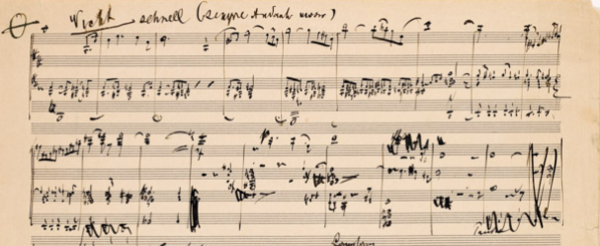
Among its 221 music manuscripts posted online, the Juilliard School possesses many unexpected items and substantial coverage of twentieth-century British and American composers (Samuel Barber, Frank Bridge) and many European composers whose music was popular in the US. Other collections represented at Juilliard include the collections of pianist Arthur Rubinstein and the popular composer of musicals Meredith Wilson (1902–1984).
Music Gifts for the Russian Emperors
Website: http://expositions.nlr.ru/MusicalManuscripts/eng/project.php
The National Library of Russia has made available this carefully curated collection of music given to Romanov emperors by visitors from France, Italy, Germany, and elsewhere. Many holdings come from Russia, where Western European music was introduced early in the eighteenth century. Holdings come from the 18th–20th centuries. Some of the music was brought by foreign teachers (e.g., Vincenzo Manfredini) for the royal progeny. Many works were provided with dedications to the emperors. Czech and Austrian music flowed copiously into Moscow at the end of the eighteenth century. A "Festival Song" by Felix Mendelssohn has a particularly interesting history, which is related here. The digitized pieces are linked to a database containing information about the social context and pertinent musical detail. The list of manuscripts (using Cyrillic script) can be found here, while a search engine (Roman script) is here. Drop-down lists contain listing in both Cyrillic and Roman, as appropriate, while the popup keyboard facilitates Cyrillic input. Source descriptions are in Russian.
Music Manuscripts in the Bavarian State Library
This rich collection of 2,697 digitized manuscripts is well endowed with music of the eighteenth and nineteenth centuries. Sample holdings include Alessandro Scarlatti's Missa Clementina, Antonio Caldara's sacred cantata "Gesu Cristo condannato", sacred vocal music by Michael Haydn, Handel's Deidamia, works by Karl Ditters von Dittersdorf, Dallapiccola, stage works by Richard Strauss, manuscripts of Carl Orff, and much other music.
The Moldenhauer Archives (Contemporary Music in Manuscript)
Website: http://memory.loc.gov/ammem/collections/moldenhauer/index.html
The Moldenhauer Archives began with the focus of teaching music history through primary sources. Its founder was Hans Moldenhauer (1906-1987) made the collection a memorial after his wife, Rosaleen, and donated it to the Library of Congress and eight other libraries including the Paul Sacher Stiftung (Basel), others in Cambridge MA, Evanston IL, Munich, Vienna, Zurich, and two in the state of Washington with which the Moldenhauers had personal connections--Washington State University and Whitworth College in Spokane. Its 3,500 manuscripts and letters, while representing a history of music and musical notation from ancient to recent times, is particularly valuable for its autographs of the latter. An online guide documents its contents, in many cases with essays on individual holdings.
Music Manuscripts in the Marciana National Library (Venice)
Website: Internet Culturale: Music Manuscripts in the Marciana National Library
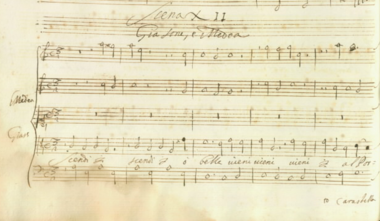
The Library of St. Mark (or Biblioteca Nazionale "Marciana") in Venice holds acquisitions that have been accumulating since the sixteenth century. Following guidelines widely shared across music libraries in Italy, it has digitized music manuscripts that are most closely tied to Venice's musical history. These include many important sources for seventeenth-century Venetian opera (Francesco Cavalli, Domenico Freschi, Giovanni Legrenzi, Carlo Pallavicino, P.A. and M.A. Ziani (operas can be accessed by act); 66 volumes containing cantatas of the eighteenth century by Benedetto Marcello (471 titles) and his nemesis Antonio Lotti; minuets by Baldassare Galuppi; and all the keyboard sonatas of Domenico Scarlatti (358 titles).
Music Manuscripts Online
Website: http://www.themorgan.org/music
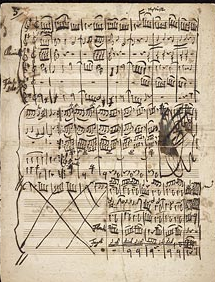
This collection of more than 700 manuscripts at the Morgan Library (New York) comes chiefly from eighteenth- to early twentieth-century composers (including but not limited to J. S. Bach, Beethoven, Brahms, Cherubini, Chopin, Debussy, Fauré, Gershwin, Glinka, Gluck, Handel, Haydn, Herbert, Liszt, Mahler, Massenet, Mendelssohn, Meyerbeer, Mozart, Mussorgsky, Paër, Pergolesi, Puccini, Saint-Saëns, Schubert, Schumann, and Wagner). An integrated browsing tool takes the viewer through music prints and manuscripts. The Library has recently made available its Goode EReader. Readers may now download images of manuscripts not currently under copyright. Searchable composer and manuscript lists facilitate individual searches.
Nuova Biblioteca Manoscritta (NBM)
Website: https://www.nuovabibliotecamanoscritta.it/catalogo.html
The Nuova Biblioteca Manoscritta (New Manuscript Library) is a regional resource for locating (and somertimes viewing) manuscripts from the modern Venetian state. It contains almost 30,000 items, but fewer than 500 of these contain music. Many other regional resources in Italy (e.g., Florence, Lombardy) and national catalogues are listed in online catalog of the Biblioteca Scuola Superiore Normale.
ORFEUS: The Post-Tridentine Music of Silence in the Cloister of S. Bento de Castris, Evora
Website: http://www.orfeus.pt
Thirteen choirbooks from the sixteenth to the eighteenth centuries in the monastery of S. Bento de Castris, Evora (Portugal), have been digitized by CIDEHUS, the Interdisciplinary Centre for History, Culture, and Societies. Luis Hennriques directs the project. The choirbooks are described individually here.
Music Treasures Consortium
Website: http://lcweb2.loc.gov/diglib/ihas/html/treasures/treasures-home.html
This aggregation includes both manuscript and out-of-copyright printed sources in more than a dozen institutions in the US, UK, and Germany. The browsing pages links users to the individual collections. The material is highly diverse but comes principally from the nineteenth century.
POLONA
Website: http://polona.pl
Polona presents the digital collections of the National Library of Poland. Digitized manuscripts and printed music are available. Registered website users can save materials to their own collections. Printed music can be found under Biblioteka, then Nuty. Manuscripts can be found under Biblioteka, then Rękopisy; from there, go to the filters and select Gatunek, then rękopisy muzyczne. Filters are available for authors, publishers, languages, form/genres, keywords, and century.
Saxon State Library (SLUB), Dresden: Royal Private Music Collection
This rich collection of the Wettin court, starting from the time of August the Strong and continuing to 1896, when it was donated to the Royal Library, is rich in holdings of sacred vocal music and Italian opera. Today it resides in the Saxon State and University Library (SLUB in the German ordering). The online holdings have been subdivided into these components:
The Opera Archive, which includes libretti, scores, and extracts, is currently being digitized. It overlaps the collaborative project Opera in Italy and Germany (1770-1830). This collection contains roughly 650 operas and opera extracts from the years 1764 to 1900. The private collections of court and church music include 750 manuscripts from the years 1697-1763.
Saxon State Library (SLUB): Court Music in Dresden
Website: http://hofmusik.slub-dresden.de
The current familiar name of this collection, Schrank II, is the name of the cabinet in which this important collection was long stored. It is a rich collection of instrumental music, mainly from the eighteenth century. Much of it is in the hand of Johann Georg Pisendel, an intrepid transcriber and collector of Italian (particularly Venetian) instrumental music. It contains 1,795 listings in 1750 physical manuscripts. By clicking on the highlighted text in the first sentence of the description users can download a spreadsheet with a full listing of holdings, most of which are digitized and are linked to the RISM OPAC.
Slovenian Digital Library
Website: http://www.dlib.si
The Digital Library of Slovenia includes in its Pictures section scans of music (and articles about music) published in Slovenia. Select notno gravido from the left frame on the Pictures tab. Dates of sheet-music publication range from 1862 to 1930, with a strong concentration in the late 1920s. Songbooks, especially from the first decade of the twentieth century, are also numerous.
Spanish Digital Library (Biblioteca Nacional Hispanica)
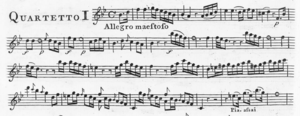
This heterogeneous collection of digitized materials--26,788 manuscripts and 4,347 printed sources--is impressive in its chronological and cultural range. Contains some eighteenth-century music for strings (Boccherini, Sacchini, et al.) and many sources from the late 19th and early 20th centuries.
By Repertory
Cambridge Lute Books
Website: http://cudl.lib.cam.ac.uk/view/MS-DD-00005-00078-00003/1
This link takes you to the second of four lute books compiled by Mathew Holmes and preserved in the Cambridge University Library. Its companions are the Cosens Lute Book and a volume of fragments of Elizabethan music for lute. Holmes was a singer at Christ Church, Oxford, and at Westminster Abbey. Cosens was a nineteenth-century owner of this collection of sixteenth-century music.
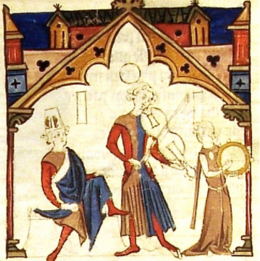
Cantigas Medievais Galego-Portuguesas
Website: http://cantigas.fcsh.unl.pt/manuscritos.asp
This website provides links to collections of manuscripts containing cantigas of Gallic and Portuguese origin. Many are preserved in the Vatican Library. The contents of each source is indexed, with full texts given in many cases. A sample folio is shown for each source. Titles are listed online.
Cantus Planus
Website: https://www.cantusplanus.at/de-at
In distinction to the Cantus Planus project focused on chant indexing (from the 1980s through today, under the auspices of the International Musicological Society), this website, operating under the auspices of the Austrian Academy of Sciences in Vienna, with a base at the Austrian National Library, provides a sophisticated array of digital tools and repositories for the study of medieval music. The scope of the project embraces six parts:
- Cantus Planus Austria: the primary web platform for the choral music in Austria
- Nationalbibliothek: Medieval music sources in the Austrian National Library
- Fragmente: Fragments of medieval music in the Austrian National Library
- Austriaca: Information on music manuscripts in Austrian libraries
- Text and Music Recognition: automatic recognition, transcription, and text acquisition of textual content in choral sourcces
- Bilddatenbank: an image bank of medieval music manuscripts.
Robert Klugseder directs the project.
Musica restaurata
Website: http://www.vaticanlibrary.va/home.php?pag=in_evidenza_art_00187
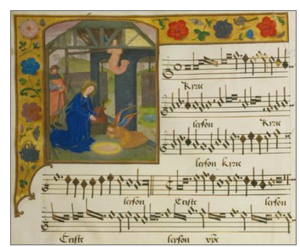
Illuminated manuscripts associated with the Low Countries in the Vatican Library can be viewed in high resolution owing to the generous support of the Alamire Foundation (Leuven, Belgium). The contents at the end of 2012 totaled 13,500 images. The image shown here comes from the workshop of Pierre Alamire (c. 1470–1536). Alamire's workshop produced many important manuscripts of the music of Johannes Ockeghem, Josquin des Prez, Adriano Willaert, and Pierre de la Rue. Alamire was a vendor of manuscripts who also used his innocent musical pursuits to conceal his operations as a spy for King Henry VIII. Manuscripts from his workshop can be found in several other European venues including Munich, Vienna, Brussels.
Polish Benedictine Music
Website: http://chrum.studiokropka.pl/st_test
This multifaceted project provides digitized images of sacred and liturgical music from Benedictine convents in the environs of Krakov. The musical sources are primarily from the 16th and 17th centuries. In addition to searchable digitized images, it also contains considerable metadata and many links to related resources as well as analytical information. An English translation is in progress.
Scottish Fiddle Tunes (Collections)
Website: http://hms.scot
More than 200 books of airs, reels, hornpipes, and strathspeys are reproduced at this website at the University of Glascow. Search by title, genre etc is facilitated in an associated databse. Some sources contain period annotations. The bulk are notated on two staves in the manner of keyboard music.
Swedish Musical Heritage
Website: http://www.swedishmusicalheritage.com
The Swedish Musical Heritage website represents an ongoing collaboration to make available all out-of-copyright music by Swedish composers. The alphabetical database of holdings is easily searched. It provides filters for instrumentation, composer's gender, century, and duration of each recording. Materials served include reproductions of scores, recordings of radio broadcasts, biographical information, and other related holdings of several musical institutions. Many Swedes were employed abroad, especially in Germany, and much foreign music found its way to Sweden via Germany.
Repertory- and Genre-Based Digitization Projects
Chant
Liber Usualis
Website: Liber Usualis
The Liber Usualis is the practical guide to chants for the Christian liturgical year. Although often considered to be ancient, it was first published in its present form in the middle of the nineteenth century. Some further accretions have occurred in recent decades. The Liber contains two cycles for the Christian year: one for the Ordinary (feasts whose liturgical needs are held in common) and one for the Proper of the Saints (feasts that are individualized in their liturgical requirements). Texts (in Latin) and music were widely paraphrased in liturgical music of the Renaissance. This version is searchable. [Fig = f. 113 of CU Add 03056: two bars from the Cosens Lute Book.]
Part-books and Choir Books
Early Music [Anthologies] Online
Website: Early Music Online
These 327 printed anthologies, held in the British Library (London), were originally microfilmed for the RISM AI project. Because of its heavy coverage of sixteenth-century prints (a high proportion of which were anthologies), it contains many real treasures--large numbers of madrigals, much of the early printed music for lute, and numerous prints in which almost all the works are by an important composer (Buus, Croce, Rore, Willaert. Seventy-seven volumes contains chansons. A smattering of treatises (Diruta's Il Transilvano, for example) can also be found here.
Bologna Partbooks (secular music)
Website: Bologna Partbooks
The holdings of the Biblioteca della Musica of Bologna are particularly rich in partbooks of the sixteenth and seventeenth centuries. Among the 339 prints found here (served by the same library but originating in the Dipartimento di Musica e Spettacolo of the University of Bologna) many secular items and some sacred vocal music can be found.
German chant and choir books
Webstie: German chant and choir books
This website serves mainly south German liturgical resources from the fifteenth century. It currently holds more than 200 items.
Munich Choir Books (mainly 16th century)
Website: Munich Choir Books
Under the musical direction of Orlando the Bavarian court (Munich) reached a peak of activity much of which resulted in the development of a substantial collection of choir books. The layout of parts in a large-format choir book enables singers to see their parts while standing around the book. The origins of this tradition can be traced to c. 1400. The 199 choir books in this digitized collection contain sacred (Isaac, Josquin, Senfl) and secular music as well as fragmentary works and an anonymous Tractatus de musica. Holdings from local monasteries and private collections have been included.
The Trent Codices (Fifteenth-Century Polyphony)
Website: The Trent Codices

This important collection of anonymous music of the fifteenth century is quite uniform in presentation, with most works employing a choir-book layout. Paper texture is well captured in the digitizations, which are highly consistent graphically. The number of titles is 1863. Few titles are attributed. Those that are come mainly from Guillaume Dufay (105 titles), Gilles Binchois (52), and John Dunstaple (30). The originals are preserved in the Castello di Buonconsiglio, Trent (IT).
Printed Polyphonic Works of the Sixteenth and Seventeenth Centuries
Website: Printed Polyphony of the 16th-17th Centuries
Similar to Early Music Online, but representing printed music in the Bavarian State Library and not limited to anthologies. It emphasizes music for voices. 1371 publication titles can be found. These include numerous early collections of chansons, madrigals, psalms, masses, motets, hymns, sacred songs, and early instrumental music (sonatas, balletti et al.). Titles in Latin, German, French, Italian, Spanish et al. Some items are of foreign origin (e.g. Purcell's Orpheus Brittanicus (London, 1698), Schmelzer's Arie per il balletto a cavallo (a horse ballet given for the wedding of emperor Leopold I and Princess Margherita of Spain, Vienna, 1667).
Opera
Opera in Italy, Austria, and Germany (1770-1830)
Website: Opera in Italy and Germany (1770-1830)
This site contains an array of resources for the study of operas (most unavailable in modern editions) that were contemporaneous with the life of Beethoven (1770-1827), who was notoriously frustrated in his attempts to succeed in the world of opera. Its holdings include 483 manuscripts, reproductions of printed libretti for every work listed, and an extensive metadata apparatus for basic information on composers, performances, and sources. Its reach is broader than the title suggests, for works performed in France, Austria, and elsewhere beyond Italy and Germany are found. In cases in which an included opera has an anterior antecedent, metadata is also given for the pre-existing opera, even when its predates the new work by as much as a century. This enables a reader to trace some of the long tendrils of gestation that might otherwise be found only in a critical edition. The manuscript sources used in Opera come from libraries in Berlin, Dresden, Munich, Vienna, and Weimar. Wolf-Dieter (romance languages) and Wolfram Steinbeck (musicology) are the project leaders.
Databases (structured)
By Repertory
Secular Vocal and Folksong Repertories
Bodleian Library Broadside Ballad Catalogue
Website: Bodleian Broadside Ballad Project
The Bodleian broadside ballad project, which was developed mainly from 1995 to 2000, spans the history of the genre. A search form enables users to access the allegro Catalogue of Ballads by sheet or ballad title, first line, and tune name as well as publisher, date, and other parameters.
César: French Theatrical Database
Website: César
The Calendrier électronique des spectacles sour l'ancien régime et sous la revolution, originally developed at Oxford Brookes University by Barry Russell and in Toronto by David Trott but expanded to include other collaborators after their deaths, offers a searchable database of personnel (broadly defined), titles, dates, venues, and pertinent treatises on the French theater of the seventeenth and eighteenth centuries. Among its most unusual holdings are its calendar of police reports from the revolutionary period.
CLORI: Archive of the Italian Cantata
Website: http://www.cantataitaliana.it/
CLORI, which hosts cantata texts, manuscript source citations, and images that show characteristics of handwriting, has a number of sponsors and collaborators including the Italian Musicological Society (SIM in Italian), the University of Rome (Tor Vergata), the Italian Institute for Music History (IISM), and RISM. The project is headed by Teresa M. Gialdroni. Click the "ricerca" button to go to the search form.
Deutsches Volksliedarchiv (German Folksong Archive)
Website: Deutsches Volksliedarchiv
The German Folk Music Archive (in German) has evolved over a century (to 2014) as a central clearing house for folk songs from German-speaking lands. It contains several component parts including (1) a Lieder Lexicon in which folksong texts are listed alphabetically; (2) a listing of specific projects, mainly those with a critical dimension; and (3) a popular Song Lexicon.
EASMUS: Early American Secular Music and its European Sources
Website: EASMUS
This extensive canvas of secular music in the American colonies of the sixteenth and seventeenth centuries consists of a series of indices (titles, first lines, musical incipits [by scale degree], stressed notes, et al.). It was developed over the 1970s and 80s by Kate Van Winkle Keller, Robert Keller, Carolyn Rabson, Raoul F. Camus, and Susan Cifaldi. The contents include ballad operas, band music, song sheets, theater works, and the names of tunes played by musical clocks.
English Broadside Ballad Archive
Website: English Broadside Ballad Archive
Six thousand English broadside ballads, mainly from the seventeenth century, are included in this comprehensive project extending to related artistic and cultural phenomena. It development continues through 2016.
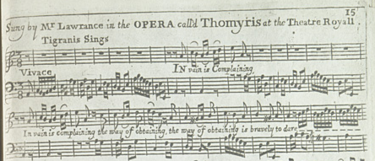
Goldberg Stiftung: Loire Valley Chanson Sources
Website: Chansonniers of the Loire Valley
The Goldberg Foundation has set up a system of hyperlinks to digitized resources for this subsector of the chanson repertory. As a collaborative project, it is somewhat uneven in its offerings. In compensation, comments can be appended to listings.
HUAPALA: Hawaiian Lyrics and Hula Archives
Website: HUAPALA
Under development since 1997, HUAPALA is a website consisting mainly of texts derived from recordings of Hawaiian traditional music. Its aim is to preserve the musical culture of the Hawaiian Islands through not only the lyrics but also associated artifacts. Some musical overlaps with Samoa and Tahiti allow for comparison of lyrics from the broader Polynesian world.
Old English Songs
Website: Old English Songs
This collection, housed at the University of Kentucky, was once owned by the double-bass player Domenico Dragonetti. The contents mainly consist of opera arias (Handel, Bononcini, Purcell) and cantatas (rather than folksongs or sea shanties) in scanned images.
Recercar (Chanson Database)
Website: Catalogue de la Chanson Francaise à la Renaissance
A search site with extensive metadata and musical incipits for a repertory of 10,000 works from the sixteenth century. Multiple settings of the same text have individual listings (e.g. "Susanne un jour" currently has 26 listings). Works can be searched by title, scoring, composer, source, location, and text. Instrumental arrangements are originally texted pieces are included.Cross-referenced to comprehensive secondary sources and modern editions.
VolksLiedWerke (Austrian Folksong Database)
Website: VolksLiebWerke
The VolksLiedWerke is assembled from collections originating in Austria's states. Search by title, personal name, or corporate name. Supported by the Austrian National Library (Oesterreichische Nationalbibliothek) and other entities. Some regions have separate websites, such as this one for the Tyrol: http://www.volkslied.at/lieder/volksmusik-db.php, where scores and recordings may also be found.
Sacred and Liturgical Music
CANTUS: A Database for Latin Ecclesiastical Chant
Website: CANTUS
Content: CANTUS is a large, steadily growing umbrella site for indices of Latin ecclesiastical chant. Originally a project of the Cantus Planus study group of the International Musicological Society, its original home was the Catholic University of America (Washington, DC) under Ruth Steiner. Debra Lacoste (University of Waterloo) is its current project manager. Jan Kolacek (Charles University, Prague) is its current developer. Users can search by textual incipit, keyword, saints’ name, liturgical occasion, and chant identification number. Tools for browsing, analysis, and data-entry are provided. Slides for Alison Altstatt's talk on Vespers of 2014 and a YouTube video by Lacoste (also 2014) give a sense of the diverse uses to which CANTUS is put.
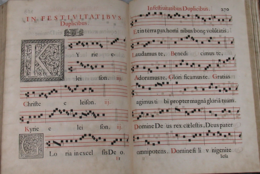
Cantus Fractus Database (Projetto Raphael)
Website: Cantus Fractus
An abiding problem in chant research is the evaluation of rhythm and proportion. This website (in Italian) by Marco Gozzi explores interpretative methods for repertories that are viewable online in early prints and manuscripts. A search form facilitates the retrieval of examples by source location. Excellent leaf-by-leaf viewing tools are provided.
ChantDigger
Website: ChantDigger
The online implementation of Max Haas's lengthy investigation of chant variants is recent. After loading the data one can search either by text or by melody. A "canvas" offers a graph to map chant movement.
Conductus: Online catalogue of poetry and musical settings
Website: Conductus
Content: Mark Everist's conductus cataogue, officially called CPI (Cantus pulcriorem invenire, contains 835 works found in 547 sources. It facilitates search by title, source, form, style of setting, stanza, poet, language, poetic structure (several subfields), and terminal accent. Sources listed are digitized and viewable online. Cross-listed to DIAMM and RISM.
Fontes Cantus Bohemiae
Website: Fontes Cantus Bohemiae
This collaboration aims to inventory chant sources in Czech regions of Central Europe. Data representing 7,200 chants from the 12th-14th centuries have been uploaded to date in CANTUS-compatible formats.
Gradualia: Hungarian Chant Database
Website: Gradualia
This CANTUS-related project stems from the earlier CAO-ECE (Corpus Antiphonalium Officii - Ecclesiarum Centralis Europae) work, which was designed to inventory and compare medieval Central European Office repertories. This undertaking aims to apply similar kinds of studies to variations in elements of the Mass. To that end a series of 14th-16th-century sources from Hungary, Poland, the Czech Republic, and Slovakia have recently been entered. Search may be made by text string, CANTUS number, and other parameters.
Mass Database
Website: http://www.mdb.uni-mainz.de/
Content: Records for c.40,000 settings of the Ordinary of the Mass from 1400 to the present day. In process of migration (March 2014).
Motet Database
Website: Motet Database
Guide to motets and Mass Propers in manuscript and printed sources from the period 1475-1600. 33,000 items, indexed section by section. Excludes Magnificats, Lamentation, canticle and strophic hymns. Extensive scribal and source detail.
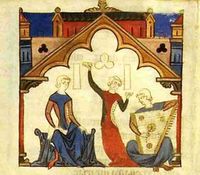
Portuguese Early Music (PEM) Database
Website: Portuguese Early Music Database (PEM)
The Portuguese Early Music Database (PEM) is a model website in that it links Portuguese music manuscript listings with both RISM entries and the CANTUS database. PEM is searchable by genre, feast, and composer. The digital holdings of the Centro de Estudios de Sociologia e Estética Musical consist overwhelming of short sacred vocal works found sources that are extremely fragile and therefore well served by digitization. Manuscripts come mainly from the 14th-16th centuries. All sources are reproduced in color. A full listing is here. PEM also maintains a list of links for early sacred-music projects.
Printed Sacred Music Database
Website: Printed Sacred Music Database
This collection of metadata and musical incipits (1500-1800) has been developed over decades under the direction of David Bryant at the Fondazione Giorgio Cini Onlus, Venice, with significant contributions by many individual scholars, and is now served at the Institute of Musicology, University of Fribourg (CH) and implemented by the Swiss RISM office. Search by composers, publishers, musical incipits, and much else. The musical incipits are encoded in DARMS and are rendered in mensural notation.
Medieval Music Database (MMD)
Website:Medieval Music Database

The original database, a model of integrated presentation combined with independent search of text and music fields, was developed by John Stinson and John Griffiths at LaTrobe University (Australia) between 1987 and 1999, when the university's music department was closed. It was maintained over the next five years by the University Library and is still accessible (2014) at the above link. Plans to bring it under the umbrella of DIAMM are under discussion.
One of MMD's great strength, for students of liturgy, is the ability to scroll bilaterally through the temporal and sanctoral cycles, that is by feasts of the Ordinary and those of the Proper. Many other search fields are supported including text, composer, genre, manuscript, and melody. MMD is cross-reference to the CAO database.
The musical examples in MMD were produced with Scribe software, also developed by Stinson and Griffiths (c. 1990). It encoded neumes and ligatures (mainly for fourteenth-century music) for printing on a color deskjet printer. It was designed the DOS operating system and could export to the SCORE music-notation program.
RELICS (Renaissance Liturgical Imprints)
Website: RELICS: A Census
This database, hosted at the University of Michigan, contains entries on c. 14,000 sources of liturgical music printed through the year 1600. Started by David Crawford (1995) and continued by James Borders, the database is contains entries from publications in Grance, Germany, and many other European countries. Coverage extends to multiple Roman Catholic rites and to Protestant and Jewish liturgies.
Instrumental Music
Classical String Quartets
Website: Classical String Quartets
Content: Duke University's Classical String Quartets website may not represent the largest collection of this repertory, but it is the largest collection of digitized prints currently accessible online. Its contents are characterized as "rare and unusual" rather than mainstream. If you are looking for variety, consider Förster, Gassmann, Pixis, or Wranitsky (a small sampling of composers represented).
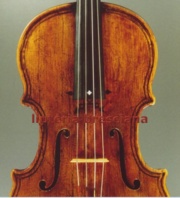
Instrument Makers
Liuteria Bresciana
Website: Brescian Instrument Makers
Brescia was the first home of violin-making. So many of the early makers died in the plague of 1630-31 that Brescia was unable to regain its former glory. It exerted considerable influence on instrument-making in nearby Cremona, which flourished after 1650. Ugo Ravasio's website (Liuteria Bresciana, which covers the period from 1550 into until the eighteenth century, mainly emphasizes the pre-1630 period.
National Music Museum
Website: National Music Museum
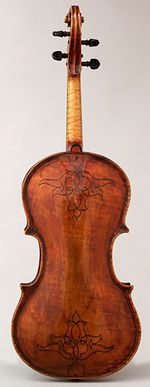
The National Music Museum (Vermilion, South Dakota, US) possesses a highly diverse collection of instruments. It also houses a program on instrument conservation. The main components of the collections are (1) the Witten-Rawlins collection of Northern Italian (Brescian-Cremonese) strings from the seventeenth century, (2) an extensive group of instruments manufactured in the US in the nineteenth and twentieth centuries, and (3) a substantial collection of instruments from other parts of the world. The NMM provides links to many other little-known collections.
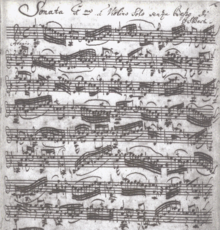
Composer/Theorist Documentation
Bach Digital
Website: Bach Digital
Bach Digital, based in Leipzig, is a one-stop shop for a catalogue of work by J.S. Bach (BWV); of scanned manuscripts; and of a database of manuscripts associated with the Bach family. When complete, it is intended to serve a wide variety of needs of scholars and interests of a wider music audience.
An earlier Datenbank der Bach-Quellen (Database of Bach Sources) operates under the auspices of Göttingen's Johann-Sebastian-Bach Institute here.
Beethoven Digital
Website: Beethoven Digital
The Staatsbibliothek in Berlin makes available close-up views of numerous details of the Beethoven's autograph for the Ninth Symphony. This view shows one of the best known passages of the work: Bars 921-922 of the Maestoso movement with the text "Tochter aus Elysium, Freude, schöner Götterfunken!" (Artaria 204(4), f. 124.) A general commentary on the nine symphonies can be found here.
Handel Reference Database
Website: Handel Reference Database
The Handel Reference Database (HRD) provides a continuously updated version of the documentation that accompanied the Stanford doctoral thesis on the reception of the music of G. Fr. Handel by Ilias Chryssochoidis.
Mozart: New Documents
Website: Mozart: New Documents
The aim of this collaborative project, managed by Dexter Edge and David Black, is to bring documentation not reported in musicological literature to public attention. Some items have been retrieved from large repositories of digitized text. A chornological list of posted documents can be found here.
Schenker Documents Online
Website: Schenker Documents Online
Schenker Documents Online (Southampton University) provides a scholarly edition of Heinrich Schenker's correspondence, teaching notes, translations of materials in German, and to show the gestation and development of his ideas. It concentrates on the period 1925-1930.
Franz Schubert
Website: Schubert Online
Schubert Online offers combined access to a total of 555 autograph scores, letters, and other documentation on Schubert. Much of the work was facilitated by the Vienna Science and Technology Fund [WWTF or Wiener Wissenschafts-, Forschungs- und Technologiefonds]. The holdings covered come from Vienna's City Hall [Rathaus], the Austrian National Library, the State Library of Berlin, and the National Library of Norway, with intellectual contributions from the Music and Psychology program in Cologne and the Musicology Institute at the University of Vienna. Full-text search is supported for the letters. Deutsch Numbers are used for the music manuscripts. In most cases copies of manuscripts must be ordered from the holding library.
Ludwig Senfl: Works
Website: Senfl Online
The most important composer in Bavaria in the first half of the sixteenth century, Ludwig Senfl (c. 1490-1543) spent almost all his life in the Munich court chapel, first as choirboy, then as musician and composer. Polyphonic incipits in mensural notation are among the items that can be retrieved by genre, voicing, and so forth. Cross-linked to DIAMM.
Giuseppe Verdi: Correspondence
Website: Verdi Correspondence (Braidense Library)
This collection of letters (1838-1883) especially concerns the countess Clara Maffei and Verdi's wife, Giuseppina Strepponi. It was placed online for the Verdi centenary in 2013 by the Braidense National Library in Milan.
Ricordi Historical Archives
Website: Ricordi Archives: Verdi Correspondence and Memorabilia
This great bulk of items in this miscellany (1786 of 2092), which includes corrspondence, scenary designs, pertains to Verdi and his dealings with Giovanni, Tito, and Giulio Ricordi, deals with librettists, casting, staging, and other production details, 1849-1893. One letter (1897) is from Giacomo Puccini.
Digitized Manuscripts and Early Printed Music
Danish National Sheet Music Archive
Website: Danish National Sheet Music Archive
The Danish National Sheet Music Archive is a model operation. Note the frame at the left, which identifies all digitized music; a special collection for flute; another for guitar; and the entire Carl Nielsen Edition available for download. Although Danish music is well served, the site includes a great deal more, including eighteenth-century manuscript, standard repertory in high-quality late nineteenth-century prints, and a special theater collection (libretti et al.).
Early Music Online
Website: Early Music Online
Early Music Online is a digital repository of music in printed anthologies principally from the sixteenth century. Based on holdings in the British Library and related to one series of RISM listings, the digitized volumes OF EMO include madrigals, sacred songs, music "concerted by voices and instruments," and pedagogical works.
National Library of Scotland
Website: National Library of Scotland
These digitized sources consist of diverse materials--memoirs, lyrics to Scottish folksongs, musical magazines, and Scottish keyboard music in multiple collections and viewing modes.
Singakademie Music Archives
Website: Singakademie Music Archives
The collection of mainly eighteenth-century vocal music belonging to Berlin's Singakademie since the time of Karl Friedrich Zelter was long dislodged by twentieth-century wars and politics. The institution's history is the focus of a project to digitize letters, documents, and materials on which prospective applications were tested. The Singakademie is also a participant in the Bach Digital and other projects related to music and musical culture of the eighteenth and nineteenth centuries.
Online Thematic Catalogues and Indices
The Bizet Catalogue
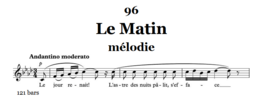
Website: The Bizet Catalogue
Every repertory has idiosyncracies that make the adoption of a standard template ill-advised. Hugh Macdonald's Bizet Catalogue shows one of Bizet's idiosyncracies through a listing of the composer's transcriptions of works by others (Gounod, Mozart, Saint-Saëns, et al.). The primary listing of works gives folio-by-folio detail of manuscripts for longer works with texts of underlying verses and notes on their authors, citations of self-borrowings, and much else.
Benjamin Britten Thematic Catalogue
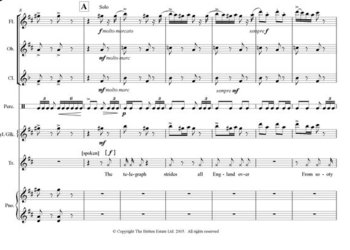
Website: Benjamin Britten Thematic Catalogue
The Britten Thematic Catalogue, an online only project based at the Britten-Pears Foundation, provides multiple access points for searching. Britten's career was extremely wide-ranging. His arrangements of music by Henry Purcell (54 titles) and of British folksongs (74 titles) filled much of his time in the 1940s and early 50s. The full gamut stretches from chamber music (134 items) mainly from the 1920s to his stage work Death in Venice (1973). Each work contains a detailed index with a graphical display and sound files.
Frescobaldi Online Thematic Catalogue
Website: Frescobaldi Online Thematic Catalogue
This database has a multi-faceted search interface. It is cross-linked to RISM IDs and has detailed source listings. (Content tends to vary slightly by source.) The general time-frame indicator gives a sense of the long tradition of recopying that followed the composer's works. Links to printed commentaries and modern editions are provided. Currently 906 works are included.
Carl Nielsen Works Catalogue
Website: Carl Nielsen Works Catalogue
The Danish National Library has prepared this online catalogue of 414 pieces, including operas, symphonies, and concertos plus vocal, choral, and chamber pieces. Each entry includes musical incipits, lists of sources and sketches, citations for textual sources, and lists of performances.

In association with the Nielsen Catalogue, implemented by Axel Teich Geertinger, an editing tool for metadata used in similar projects has been developed by Sigfrid Lundberg and can be downloaded from Github. Based on MEI, the foundation of MerMeid was laid by Kristine Richts and Maya Hartwig. Further details about MerMEId and a sample implementation can be found at this site.
Ethnomusicology

Images, sound files, and videos on the internet offer great scope for ethnomusicological study, but much of the material is limited to poorly documented materials with arbitrary labels. Only selected sites can be included here.
UNC Middle Eastern Music

Website: Middle Eastern Music
The University of North Carolina offers top-down collections of selected repertories from Egyptian, Turkish, Iraqi, and classical Persian music. Each site varies from the others. Explanatory material concerning composers, instruments, styles, and cultural emphases are general to most. The Farabi site also discusses theoretical concepts in Persian classical music. The Turkish one contains many sound examples.
Digital Image Archives
Digital Image Archives of Medieval Music
Website: DIAMM
Originally a site for viewing images of rare manuscripts at various levels of resolution, DIAMM is increasingly an umbrella site for diverse projects in medieval music. The core textual database is organized by source location. Registered users may add their own comments about individual works. List and faceted search capabilities are currently being added. Now includes an online teaching resource for musicians wishing to learn more about the notation of medieval music. Register at http://diamm.nsms.ox.ac.uk/moodle/.
Emblematica Online
Website: Emblematica Online
This umbrella project serves a growing number of library-based projects, which are here cited individually. Emblem books are rich resources for those interested in decoding visual information in early printed materials. The collective site currently (April 2014) lists 636 emblem books. Searches by title, text, and image are supported.
Herzog August Bibliothek (HAB)
Website: Herzog August Bibliothek Emblem Books
This website makes available 636 emblems books, principally from the 17th and 18th centuries. It represents only a tiny fraction of the rich holdings of the Herzog August Bibliothek, which is particularly rich in seventeenth-century materials. August the Younger developed a three-tiered description system still in use today. Its librarians later included the polymath G. W. Leibniz (1691-1716) and the poet and dramatist G. E. Lessing (1770-1781).
University of Illinois
Website: University of Illinois Emblem Books
Germans sources figure prominently among the 351 books at the University of Illinois site, which is cross-linked to one at the Herzog August Bibliothek in Wolffenbüttel.
French Emblems at Glasgow
Website: French Emblems at Glascow
This site hosts 27 browsable emblem books associated with 16th-century France. Eack book islinked to an alphabetical listing by author that enables rapid exploration. Some sources are bilaterally in Latin. A smaller collection of Italian emblem books is also held.
Rare Music Manuscripts in the British Library
Website: Rare Music Manuscripts in the British Library
Content: See the Old Hall manuscript, Purcell's coronation anthem for James II, an excerpt from Handel's Messiah, Bach's autograph for Book Two of the Well-Tempered Clavier, Mozart's thematic catalogue of his composition, Beethoven's sketches for the Sixth Symphony ("Pastoral"), and much else. (Music manscripts make up just one part of the holdings viewable at this portal.)
Musica Sacra
Website: Musica Sacra
Content: notable collection of scanned chant books at http://musicasacra.com/music/ and http://musicasacra.com/resource-lists/. Includes the Liber Usualis and many other resources for modern use in traditional settings.
Resources for Chronology
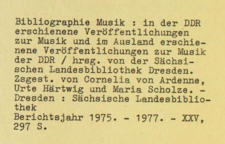
Music Bibliography in the German Democratic Republic
Website: Annual Music Bibliographies in the German Democratic Republic
Music Bibliography in the German Democratic Republic (Deutsche Demokratische Republik or DDR, 1949-1990) is an idiosyncratic subject but one which those engaged in music history of the second half of the twentieth century may find compelling. The illustration accompanying this entry shows the full title of a typescript catalogue of new works (scores, writings on music theory, books, articles, and much miscellany) for the year 1975. This item can be found here.
Hofmeister XIX
Website: Hofmeister XIX
Content: Database of 330,000 records from the Hofmeister Monatsberichte, 1829-1900, listing music publications of the period. Compiled by Friedrich Hofmeister and published in Leipzig by Breitkopf & Härtel. Well indexed for quick searches.
Libretto Portals
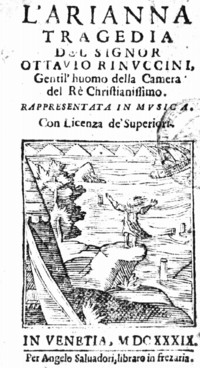
Corniani-Algarotti Collection
Website: Corniani-Algarotti Libretto Collection
Although the search form shows only four fields, the name field (nome) will accept almost any proper noun (surname of composer, librettist, scenographer, city, theater, etc.). Most sources are digitized and downloadable. This collection holds 9,000 libretti (in Italian) from the sixteenth through the nineteenth centuries. Some were published and used outside Italy. Most texts were for operas, but oratorio, cantata, and serenata texts can also be found.
VifaMusik Libretto Portal
Website: http://libretti.digitale-sammlungen.de/de/fs1/start/static.html ViFaMusik Libretto Portal
The new (2014) VifaMusik Libretto Portal searches across component collections held in the Bavarian State Library (5600 items), the Frankfurt University Library, and the Library of the German Institute in Rome (1500 titles). One can search by composer, librettist, and so forth. Since the term libretto referred to any small book, texts for oratorios, cantatas, serenatas, ballets, and so forth occur in some of the constituent collections.
Index to Opera and Ballet Sources Online
Website: Index to Opera and Ballet Sources Online
This title index for individual works relies on aggregators (the Braidense Raccolta Drammatica, ViFaMusik, the Internet Culturale, et al.) for most of its contents. Since it does not distinguish between different versions of single titles, those with an acute interest in a defined topic may still wish to consult the aggregations. It relies on five data fields: title, composer, genre, format, and date. Its principal holdings are libretti. Some links to scores can also be found. The advance search tool at atom.lib.byu.edu/opbs/advanced allows one to search with individual aggregations.
Digitized Music Bibliographies
Eitner's Quellen-Lexikon
Website: Eitner's Quellen-Lexikon
Robert Eitner's Quellen-Lexikon, published by Breitkopf & Härtel between 1900 nand 1904, was the Bible for generations of scholars seeking to determine which libraries held surviving manuscripts of music from the sixteenth and seventeenth centuries. Although a portion of these sources are gradually finding their way online, Eitner remains an invaluable record of what sources existed before 1914. The scanned material was proofreading and corrected prior to posting. This site is hosted by the Musicology Institute of the University of Zurich.
Portals and Search Engines for Music
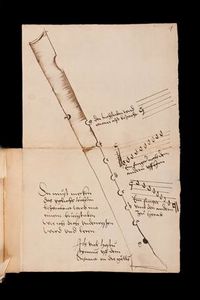
e-manuscripta
Webite: e-manuscripta
This comprehensive portal for materials in Swiss libraries serves scores, photographs, letters, pedagogical materials, and much else. The five-leaf recorder tutor (from a sixteenth-century manuscript) shown at the side represents its heterogeneity, which also extends to sixteenth-century part-books, organ tablatures, correspondence by Martin Luther, photographs of Ferruccio Busoni, and a thousand maps.
Europeana: Search Engine for European (Music) Sources
Website: Europeana
This umbrella site for European digitization projects covers a great deal besides music. To start, limit the search by an obvious word for music (musique, musica, Musik, etc.). This will give you an idea of how to further limit the search. Europeana is updated often. Among the items that should be visible are music prints, manuscripts, newspapers dedicated to music, sheet-music, audio files, etc. Since Europeana is an aggregation, it provides links back to the sponsoring libraries that hold the original sources. The site can be searched in many languages.
Gallica
Website: Gallica
Gallica provides access to an enormous array of digitized materials from all periods of French history and many aspects of French musical life in addition to great quantities of non-musical material. Among its highlights are illuminated manuscripts contained the poetry (much of it set to music) by Guillaume Machaut), manuscripts of the operas Francesco Cavalli composed for the wedding of Louis XIV, a very large amount of music printed in France in the eighteenth and nineteenth centuries, and important documentation for theatrical history.
The Internet Culturale
Website: Internet Culturale
An umbrella site for digitized materials in Italian libraries. The riches of Italy's collective Internet Culturale (cultural internet) are difficult to overstate. A vast span of different kinds of graphically reproduced material will be found here. All of it is accompanied by generous supplies of metadata from cataloguing records. While one may be able to find a specific item such as an , one may also discover on a different spoke a long list of all the works in which the singer of aria appeared. Users can create accounts to keep previous discoveries collected in one place.
Munich Digital Manuscript Collection
Website: Munich Digital Library Manuscripts
The collection of digital materials grows so rapidly that any listing of individual collections within it is doomed to be inadequate. Several project are cooperative. The historical emphasis is on Middle Ages and Renaissance, with much emphasis on religious figures and documents (e.g. at Europeana Regia). A combined search engine (http://www.digital.collections.de) for all the digitized materials in the Bavarian State Library is currently under development.
Peachnote Music n-Gram Viewer
Website: Peachnote n-Gram Viewer
MIDI-based search by string.
RISM Music Manuscript Inventory
Website: RISM Music Manuscript Inventory
This inventory of musical manuscripts in the libraries of roughly 60 countries was begun in 1952. It is still growing (under the management of the Répertoire International des Sources Musicales). The online implementation occurs in the Bavarian State Library. RISM's numerous virtues are easily discovered through this search engine, which came online in 2011 and undergoes continuous development. A RISM blog keeps registered users informed of current activities. RISM has working groups on most continents. Much material that is currently contained in RISM books will (with updating) likely find its way online over the coming years. Those interested in contributing to RISM's efforts can find a local representative by consulting this list.
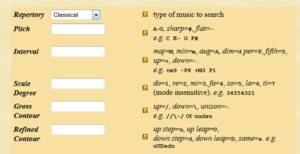
Themefinder: Music-Incipit Search
Website: Themefinder
Related literature: "Search-Effectiveness Measures for Symbolic Music Queries in Very Large Databases" (Craig Stuart Sapp, Yi-Wen Liu, and Eleanor Selfridge-Field)]
The Themefinder search engine was prototyped at CCARH in 1996 by David Huron, Andreas Kornstädt, and Walter B. Hewlett. A large number of Stanford University students including Unjung Kim and Leigh VanHandel plus visiting students including Bret Aarden participated in its early development. The search engine was originally developed to study user behavior. Over the intervening years it has been used for a large statistical study of search-efficiency. The current search engine is by Craig Stuart Sapp.
Themefinder contains several repertories, most of which are publicly viewable and searchable. The principal repertories are Folk, Classical, and Renaissance. Although more than 100,000 incipits and associated metadata are present in the database, users may select just one. "Hits" satisfying search-criteria can be collected on the Themefinder Clipboard and can be exported.
Incipits can be searched at five points on a continuing from the most specific to the fuzziest. Filter for meter, mode, and key may be used. MIDI files are available for each entry. Help menus area available at the website. Those interested in contributing an encoded repertory to Themefinder should describe the existing repertory and format in a query letter.
Music Theory Resources

Additional materials can be found on the homepage of the Center for the History of Music Theory and Literature at Indiana University, available at CHTML, the Center for the History of Music Theory and Literature.
Early Music Theory
Website: Early Music Theory
Early Music Theory subsumes the new digital edition of the works of Johannes Tinctoris. Twelve treatises are listed on the earlier Stoa site, and three are viewable.
German writings on music theory and musical institutions
Website: Writings on Music Theory
This digitized collection (176 titles) from the Bavarian State Library emphasizes works printed between 1516 (Glareanus, Basel) and 1900. It includes a number of books related to individual theaters (mainly German).
Lexicon musicum Latinum
Website: Lexicon musicum Latinum
This lexicon of musical terminology up to c. 1600 extends to evidence of speech, literary references, music-theory manuscripts, and first lines of tracts.
Monuments of Partimenti
Website: Monuments of Partimenti
Robert Gjerdingen's online website for partimenti introduces the basic approach to improvisation and composition based on suggestive figured-bass sketches that survive, according to the seminal work of Giorgio Sanguinetti's The Art of Partimento (2012), in abundance from the eighteenth century. The website is still under development, but between the materials available here and the companion site linked to the book (above), users can form an elementary notion of the practice.
Saggi Musicali Italiani
Website: Saggi Musicali Italiani (SMI)
A collection of encoded music-theory treatises modeled on the original TML design. Now headed by Andreas Giger. Sources from the fifteenth through the eighteenth centuries are currently available.
Thesaurus Musicarum Latinarum
Website: Thesaurus Musicarum Latinarum (TML)
The TLG, based at Indiana University School of Music, was begun in 1990 and extensively developed by Thomas Mathiesen, with the collaboration of many scholars in the US and abroad. TML was one of the earliest databases (and likely to earliest in musicology) to be fully searchable in a single pass.
While this database is exclusively devoted to writings in Latin from antiquity to the seventeenth century, the rise of parallel efforts for digitizing the texts of music-theoretical writings in modern languages spawned several parallel efforts, which are now subsumed under the title CHTML (the Center for the History and Theory of Music Literature). Giuliano Di Bacco, who now heads the project, is at work on new digital approaches to structuring and searching the material.
Thesaurus Musicarum Italicarum
Website: Thesaurus Musicarum Italicarum (TMI)
Frans Wiering's Thesaurus Musicarum Italicarum, which is entirely separate from the TLG, representeda second incarnation of his CD-ROM encodings of all the treatises of Gioseffe Zarlino (1995). The CD offered all the musical examples as MIDI and DARMS files as well as modern notation. Its viability was undermined by the evolution of operating systems in the early 2000s. Other works of Italian music theory from the decades following Zarlino were encoded subsequentlyby students at Utrecht University.
Traités français sur la musique
Website: Traités français sur la musique
This website, based on the model of the TML, offers encoded texts of French music theory principally postdating the year 1600. Peter Slemon is the originator and director. To subscribe, please visit the website.
Historical Audio and Video (Film)
The history of performed music is a compelling interest of a growing sector of musicology. Incremental changes in the retrospective reach of copyright in the several countries that were most active in early recording activities inhibit public access to exemplars. Work proceeds nonetheless. Only sites with accessible material are listed here.
The Edison Recorded Sound Archive
Website: Edison Recorded Sound Archive
This collection, administered by the US National Park Service (Thomas Edison's lab is classified as a national historic park), holds 11,000 cylinder recordings and 38,000 disc recordings from the years 1898-1929. Some recordings have been reissued on CDs. In general users may request the copying of one recording at the time. No online access is currently provided from this site, but some materials can be found at other sites. The Archive is rich is related holdings, including black-and-white photographs of early performers (c. 5,000) and correspondence.
Three hundred forty-one silent films made by the Edison company between 1898 and 1912 can be found at the Library of Congress's Inventing Entertainment website.
The Emile Berliner Collection
Website: The Emile Berliner Collection
The inventor of the microphone and the disc recording, Emile Berliner (1847-1929) is survived by 400 documents and 118 sound recordings in the Library of Congress. Like Edison, he experimented with film as well. Digitization of the collection is in progress.
Internet Archive 78RPMs
Website: Internet Archive 78 PRMs
Recordings mastered for 78 rpms (revolutions per minute) were produced prolifically from the 1920s into the 1950s. The Internet Archive collection includes cylinder recordings and 78s. It is searchable in several ways. The download statistics shows that the most popular holdings are songs sung by Enrico Caruso, Bill Murray, Edith Piaf, and Al Jolson. Current holdings number 13,200.
The National Jukebox (US)
Website: The National Jukebox
The National Jukebox, serving selected holding of the Library of Congress in Washington DC, certainly give the flavor of recording. Much of their material comes from the Victor Company (later RCA Victor) and the Berliner Company. It currently (2014) serves more than 10,000 works but remains a work in progress. A substantial range of popular and folk songs from c. 1900 reflects the great ethnic diversity of the U.S. in that era. Yet more than half the materials were recorded in Camden NJ (the home of the Victor Company). Users add the works they want to hear to a playlist and hear streamed examples (the best current workable solution to rites issues). Most available holdings are from the years 1900-1930.
New Zealand Pianola Site
Website: New Zealand Pianola Site
The New Zealand Pianola website is well-known to honky-tonk enthusiasts. Through painstaking research over many years, many hundreds of piano-roll performances have been captured in MIDI files of high quality. The user interface makes searches and launching sound files simple. The music comes mainly from the years 1900-1930. Zipped packages of files can be downloaded. At last reckoning 1040 files were available.
Historical Maps
British Historical Maps
Website: British Historical Maps
The National Archives (UK) hosts a large collection of maps and also has links to parallel materials with similar content.
David Rumsey Map Collection
Website: http://www.davidrumsey.com
Contents: 18th and19th century maps of the Americas. All maps are geo-encoded to facilitate geo-spatial and past-time applications.
Perry-Castañeda Historical Maps
Website: http://www.lib.utexas.edu/maps/historical/index.html
Notable for its spatial and historical spread and the detail with which the maps are specified chronologically. Many sources are scanned from maps printed in then nineteenth (or earlier) century.
Newspapers
ANNO
Wesbite: Historical Austrian Periodicals and Newspapers
Newspapers were published in Austria on Wednesdays and Saturdays. Readers will be grateful for the calendars that introduce each year of the collection (e.g. for 1705) and also for the thumbnails of each page of every issue. Almost a century (1606-1703) remains to be added. The overall range is from 1568 to today.
"Chracas" Digitale: Il Diario di Roma
Website: Chracas Digitale
This "diary" of news flowing into Rome from all over Europe was introduced as the Diario d'Ungheria [the Diary of Hungary] in 1716. It followed the earlier pattern of weekly avvisi that reported military news. That model was soon replaced (1718) by the more culturally oriented Diario ordinario. Under this title it rapidly gained readership. By 1721 it was publishing three issues a week. Most contain 12 pages. In 1799 the title changed to the Diario di Roma. Chracas remained its publisher until 1894. At present issues from 1716 to 1760 have been digitized by the Biblioteca Casasnatense, Rome.
The Gazzette Bolognese
Website: Gazzette Bolognesi
The Gazzette Bolognesi have intended parallels with the Diario di Roma. Bologna was historically a papal state. It gathered the same news and valued it similarly, though occasionally with less emphasis on the affairs of cardinals. Because of larger page size the Gazzette could convey more news from more places. (The Gazzette had only four pages per issue.) This fully digitized series runs from 1645 through 1796.
Le Mercure galant
Website: Le Mercure galant
Many issues of Le Mercure and its analogues under variant titles (Le Mercure de France et al.) can be found be searching the Bibiliothéque National's Gallica website (as above). Single installments accrue steadily but some holes remain. User must be aware of the periodical's complex history of changes in title and differences of character that each portends.
Music Magazines
Musical Magazines
Start site: Musical Gazzettes
Almost 25,000 musical magazines published in Italy before the first world war have been digitized by the Centro internazionale di ricerca sui periodici musicali (The International Center for Research on Musical Periodicals) in Parma. Among there holdings the most prolific were Milan's Gazzetta Musicale di Milano, London's Musical Standard, and Paris's Revue et gazette musicale. The best way to find them from this start site is to use the filters for language and date of publication at the left.
The Phonographic Newspaper
Website: Phonographische Zeitschrift
The Photographische Zeitschrift (Phonographic Newspaper) was published on poor-quality paper from 1900 to 1938. It was subtitled "a fact sheet for the music- and speech-making industry". This site is under development (2014).
Large Text Corpora
Deutsches Text Archiv
Website: Deutsches Text Archiv
This carefully executed project aims to put the classic printed literature in German online. Its holdings are far better curated that the same titles in Google Books and other aggregation gateways. Optically recognized text is shown side-by-side with the original image. Books are categorized by century (according to date of publication). Contains dramas (Goethe), treatises (Karl Marx), autobiographies (Otto von Bismark), lyrics (Brockes, Klopstock), novels (Jean Paul), legal writings, local history, travel literature, theology, satire, and a long list of short-run early newspapers. The great strengths of the DTA include its internal search, its side-by-side view original and recognized text, and its tiered metadata structures.
Digital Libraries Gateway
Website: Collaborative Digital Libraries Gateway
This Library of Congress gateway for international projects gives an overview of collaborative projects with an American component and currently including Brazil, France, the Netherlands, and Siberia.
Medieval Nordic Text Archive
Website: Medieval Nordic Text Archive (MNTA)
The MNTA is a TEI-complaint collection of writings in old Scandinavian languages. It offers users an appropriate text font and an encoding manual for those who wish to collaborate.
Oxford Text Archive
Website: Oxford Text Archive (OTA)
The OTA was begun on mainframe computers with the curated encoding of texts important for the study of the languages and literatures both early and modern. Its website contains numerous links to tools and related projects.
Perseus
Website: Perseus
Perseus was originally developed by Gregory Crane at Tufts University with the aim of enabling students to focus on small portions of the classical literature encoded by PHI and the TLG. It subsequently expanded to incorporate many other aspects of classical civilization, including graphical explanations of textual references, as for example here. Its catalogue is online. It is now expanding into other cultures and later periods. For each of these a digital lexicon is available. This one is for Arabic-English translation.
PHI Latin Texts
Website: PHI Latin Texts
These classical Latin texts (200-c. 600 CE) encoded by the Packard Humanities Institute are easy to search. The search engine (also developed in-house) is focused on letter combinations and word proximity (see the and/or/near operators).
Rousseau Online
Website: Rousseau Online: Contents
Rousseau's writings contain countless items of interest. Here you can find the text of Pygmalion, Rousseau's Essay on Modern Music, his letters to Charles Burney and Messieur Raynal, the Dictionnaire de la Musique, and a host of miscellaneous writings from all periods of his life. The script is modern. ePub and PDF formats are both supported.
Thesaurus Linguae Graecae
Website: Thesaurus Linguae Graecae (TLG)
The TLG issues from a pioneering effort to develop tools for the computerized study of ancient Greek. This effort preceded the advent of personal computer by a decade. Because of the need for special fonts, the collection is still mainly distributed on CD-ROM. An abridged version of the TLG is now online. It requires the advance download of a viewing font. The TLG website is now linked to a searchable online version of the Liddell-Scott-Jones Greek-English Lexicon.
Image Resources
Digital Scriptorium
Website:Digital Scriptorium
Image database of medieval and renaissance manuscripts. Based at the University of California, Berkeley, it includes holdings from many US libraries, with extensive folio-specific information about each source.
Index of Christian Art
Website: Index of Christian Art
One hundred twenty thousand (120,000) images from public and private collections in the English-speaking world plus additional indicies; roughly 100,000 are available to public via fee-sbased institutional subscriptions. Holdings from early centuries of Christianity to 1550.
Songs of the Niebelungen
Website: Das Niebelungenlied
These poetic texts, considered to date from before 1280, display settings of the legends that inspired Richard Wagner. As is characteristic of those resources preserved for posterity in this period, the script is very carefully prepared, the vellum on which it is preserved obviously sturdy. Each Lied is illuminated by a carmine letter. The texts mention Sifriden (Siegfried), Prvnhilde (Brunhilde), Gvnther (Gunther), and others. The illustration shows the first three stanzas of "Wie Gvnther Sifriden zvo der hohzit bat" (No. 12 of 39). Later portions of the source contain religious songs (Klage).
Watermark Databases
Watermark examination provides a fundamental (analogue) method of sorting and ordering materials that are undated or lack a provenance. They are especially useful for clustering manuscripts by paper type. The combination of digital photography and tools for photographic editing can be combined with extensive existing research on paper-makers to shed new light on musical sources. The sites listed here include watermarks associated specifically with music manuscripts.
WZIS: Watermark Information System
Website: Wasserzeichen Informationssystem Deutschland
The WZIS is a project of extensive scope. Its goal is to compile a graphical database of watermarks used throughout Europe. The project is based at the Landesarchiv of Baden-Württemburg. A graphical watermark lexicon called Piccard is under development at the Stuttgart Hauptstaatsarchiv. Related lexicons of makers and mills have also been developed. A textual search form is also available. Although we are aware of many other digital collections of watermarks, this one stands out for its tight coupling with music manuscripts, particularly in the large collections of the Berlin and Dresden state libraries, which are in turn linked to the RISM OPAC.
Credits
2014 Center for Computer Assisted Research in the Humanities, an affiliate of the Packard Humanities Institute, at Stanford University. Compilation and brief explanations by Eleanor Selfridge-Field (with contributions by many colleagues), technical implementation by Craig Stuart Sapp, and assistance by Ilias Chrissochoidis. Persistent URLs have been used where available. For contact information please use this link.